Kuršo tvirtovė II Antrasis pasaulinis karas
Kuršo kišenė arba Kuršo tvirtovė arba Kuršo katilas (latv. Kurzemes katls, Kurzemes cietoksnis, vok. Kurland-Kessel, Kurland-Festung; rus. Курляндский котёл, блокада Курляндспкой projektuoja theвкокогрондспкой) Kuržemės ir iš dalies Žiemgalos regionų teritorija, kur per Antrąjį pasaulinį karą, nuo 1944 m. spalio mėn. iki 1945 m. gegužės mėn., Vokietijos armijų grupė „Šiaurė“, vėliau pervadinta į Kuržemės armijų grupę, buvo atkirsta 1-ojo ir 2-ojo Raudonosios armijos Baltijos frontų.
Kuršo kišenė ir Kuršo tvirtovė Antrojo pasaulinio karo metu buvo naudojamos propagandos tikslais.
Jūsų komentarai
Susijusios vietos
Saldaus vokiečių kareivių kapinės
Saldaus vokiečių kareivių kapinės yra prie Saldaus–Ežerės plento. Kapinėse, užimančiose 8 hektarų plotą, yra apie 25 000 vokiečių kareivių, taip pat kai kurių Latvijos legionierių palaikai. Perlaidojimai vyksta nuo 1997 m.
Nuo gegužės 1 d. iki spalio 1 d. memorialiniame kambaryje galima apžiūrėti parodą apie Kuršo mūšius. Šiuo laikotarpiu memorialinis kambarys dirba darbo dienomis nuo 9:00 iki 17:00 val., o šeštadieniais ir sekmadieniais kapinėse dirba ir gidas. Taip pat galima susipažinti su Saldaus vokiečių kareivių kapinėse palaidotų ir visoje Latvijoje žuvusių kareivių sąrašais.
Privati karinių daiktų ir siuvimo mašinų kolekcija
Vienintelė Latvijoje siuvimo mašinų kolekcija, kurioje yra daugiau nei 200 skirtingų siuvimo mašinų iš ikikario ir sovietmečio laikotarpio, kurios atliko tiesioginį vaidmenį karinės aprangos gamyboje ikikario ir karo metais. Kolekcijos kūrėjas - Juris Beloivans.
Sovietinių kareivių kapinės „Tuški“
Raudonosios armijos 130-ojo Latvijos ir 8-ojo Estijos šaulių korpuso karių broliškos kapinės yra apie 350 metrų į pietvakarius nuo Blīdenės-Remtės kelio. Pavadinimas kilęs nuo Tuški ūkio, kuris buvo 400 m į pietus nuo kapinių.
1945 m. kovo 17 d. prasidėjo paskutinis Raudonosios armijos bandymas Kuržemėje. 308-oji Latvijos šaulių divizija puolė į pietvakarius ir vakarus nuo Tuškių sodybos ir per tris kovos dienas kirto Blīdenės-Remtės kelią aukštumų 142,2 rajone ir pasiekė Jaunāsmuižos-Mezmalių liniją. Mūšių metu žuvę kareiviai buvo palaidoti keliose mažose kapinėse netoli Ķėkių, Vērotojų, Jaunāsmuižos ir kitur.
Septintojo dešimtmečio pabaigoje, Sovietų Sąjungai pradėjus minėti Antrojo pasaulinio karo aukas, į šiaurę nuo Tuškų sodybos griuvėsių buvo įkurtos naujos kapinės, kuriose buvo planuojama perlaidoti visus Pilsblidenės ir Kaulačių apylinkėse žuvusius karius. Iš tikrųjų perlaidojimas buvo dalinis, nes labai dažnai žuvę kariai likdavo savo pirminėse kapavietėse, o Tuškų brolių kapinėse būdavo perrašomi tik jų vardai. Tuškų brolių kapinėse taip pat galima rasti 8-ojo Estijos šaulių korpuso karių, kurių pagrindinės karo laikų kapinės buvo dabartinių Pilsblidenės kapinių vietoje, vardus.
Taip pat yra paminklas Jakobui Kunderai, 8-ojo Estijos šaulių korpuso kareiviui, kuriam skirtas objektas „Kunderos taškai“. Iškart po mūšio Jakobas Kundera buvo palaidotas dabartinėse Pilsblidenės kapinėse, o vėliau perlaidotas Tuškų brolių kapinėse.
Atstatyti vokiečių armijos apkasai Melnsils stovyklavietėje
Kempingas „Melnsils“ yra įsikūręs prie jūros, 10 km nuo Kolkos. Čia pastatyti vokiečių armijos tipo apkasai, kuriuose galima apsistoti nakčiai. Tai užuomina į šio regiono istoriją, kai Antrojo pasaulinio karo metu vokiečių armija čia turėjo pasienio apsaugos postą ir stovyklavietę, o kareiviai statėsi apkasus iš netoliese rastų medžiagų. Pakrantės kopose vis dar galima rasti apkasų.
„Bunkeris Nr. 13“ yra didžiausias iš dviejų bunkerių, kuriame yra trys dviaukštės lovos. „Mažasis bunkeris“ yra mažesnis ir jame yra dvi dviaukštės lovos. Kempingas „Melnsils“ – puikus pasirinkimas aktyviam poilsiui ir sporto renginiams iki 300 žmonių. Jis įsikūręs netoli Sliterės nacionalinio parko, pakrantės skardžių ir miško pėsčiųjų takų. Rajone yra pažymėti dviračių takai, vingiuojantys per natūralią aplinką. Prie jūros yra įrengtos vietos palapinėms ir laužavietėms, taip pat statinės tipo svečių nameliai dviems ar keturiems asmenims. Taip pat yra pirtis su įvairių rūšių vantomis.
Vainodės stotis
Geležinkelio stoties pastatas buvo atidarytas kartu su Liepojos–Vainodės geležinkelio linijos statyba 1871 m. Pats stoties pastatas buvo atidarytas 1872 m. Tai taip pat buvo didelės veiklos, plėtojant Vainodės centrines gatves, pradžia. Reikšminga tai, kad to meto vadovuose kiekvieno pastato ar objekto atstumas buvo nurodomas kaip atstumas nuo geležinkelio stoties. Geležinkelio stotis kadaise buvo svarbus karinis transporto mazgas.
Pirmojo pasaulinio karo metu nuo stoties iki aerodromo buvo nutiesta atšaka, kuria buvo atgabenamos medžiagos (metalinės formos angarams), kranai, gervės ir amunicija karo atsargoms, kurios vėliau cepelinais buvo gabenamos į Rygą ir bombarduojamos rusų įtvirtinimai.
Geležinkelio stoties pastatas nebuvo nuniokotas Antrojo pasaulinio karo ir laikui bėgant nepakito savo išvaizdos. Vainodės stotį galima pamatyti iš išorės.
Karinė veikla Vainodės apylinkėse siejama su sėkmingu Raudonosios armijos puolimu, prasidėjusiu 1944 m. spalio 5 d. Šiaulių apylinkėse. Greitai sutriuškinę silpną vokiečių pasipriešinimą, sovietų tankų daliniams buvo pavesta užimti strategiškai svarbią Liepojos–Šaulio geležinkelio liniją. 1944 m. spalio 9 d. ankstyvą rytą puolimą pradėjo pirmieji 19-ojo tankų korpuso 79-osios tankų brigados daliniai ir atskiri 143-osios tankų brigados daliniai. Žlugus vokiečių frontui, rytiniame Vainodės pakraštyje buvo tik nedideli vokiečių 61-osios pėstininkų divizijos daliniai, remiami šarvuočių. Pasipriešinimas buvo greitai įveiktas ir spalio 9 d. vakare visą Vainodę visiškai kontroliavo Raudonoji armija. Spalio 10 d. atvyko sovietų 6-osios gvardijos armijos 103-ojo šaulių korpuso daliniai ir tęsė atakas, atstumdami vokiečių 61-ąją pėstininkų diviziją 2 km į šiaurę nuo Skaistkalnės sanatorijos. Sovietų pajėgoms užimant Vainodę be didelių kovų, Vainodės stotis ir miesto pastatai nukentėjo palyginti mažai.
1944 m. spalio 24 d. kovos šiek tiek priartėjo prie Vainodės, kai vokiečių 10-asis korpusas, vadovaujamas 14-osios tankų divizijos, įvykdė puolimo operaciją, pravarde „Eberhardas“. Kovų metu fronto linija sutelkė jėgas į šiaurę nuo sanatorijos ir ten išsilaikė iki spalio 27 d., kai Raudonoji armija pradėjo puolimą, vadinamą 1-uoju Kurlando bolševiku.
Pilsbidenės dvaras
Dvaro rūmai buvo pastatyti klasicistinio stiliaus XIX a. 3-ajame dešimtmetyje. Po žemės reformos dvaro kompleksas buvo nuomojamas privatiems asmenims, tačiau nuo 1932 m. atiteko Liaudies gerovės ministerijai.
6. Per įnirtingus Didžiojo Kuršo mūšio mūšius jis buvo naudojamas ir kaip atramos postas, ir kaip ligoninė.
1945 m. kovo 17 d. prasidėjo paskutinis Raudonosios armijos bandymas pulti Kuršą. Vokiečių 24-osios pėstininkų divizijos daliniai gynėsi Pilsblīdenės dvaro komplekso apylinkėse. 1945 m. kovo 18 dvarą iš pietų puolė 43-iosios gvardijos Latvijos šaulių divizijos 121-asis šaulių pulkas, tačiau nesėkmingai. Iš vakarų puolė 7-osios Estijos šaulių divizijos 300-ojo šaulių pulko 1-asis batalionas, o dienos pabaigoje 3-iojo gvardijos mechanizuotojo korpuso 35-oji tankų brigada Blīdenės-Remtės kelyje prisijungė prie 249-osios Estijos šaulių divizijos 917-ojo šaulių pulko 1-ojo bataliono.
Kovo 19-osios naktį 19-osios Latvijos SS Grenadierių divizijos 43-iasis Grenadierių pulkas atvyko į Blīdenės stoties apylinkes ir kontratakavo, siekdamas atsiimti Pilsblīdenės dvaro gyvenamąjį pastatą. Tačiau po naktinės tankų atakos stotyje įsitvirtino Raudonosios armijos estų ir latvių daliniai.
1959 m. pilyje kilo gaisras. Nuo 1961 iki 1986 m. gyvenamajame pastate veikė senelių namai. 1986 m. pilį vėl sunaikino gaisras. Nuo to laiko pilis stovi tuščia ir apgriuvusi.
Dvaro rūmus supa 24 hektarų parkas, kuris dabar apaugęs. Parke yra apie 37 nevietinių medžių ir krūmų rūšių plantacijos, jis yra saugomas valstybės. Parkas neprižiūrimas, o aplinka apaugusi.
Ezerės kraštotyros saugykla „Muitas Nams“
Ezerės muitinė yra Ezerėje, netoli Saldaus-Mažeikių plento, Latvijos ir Lietuvos pasienyje. 1945 m. gegužės 8 d. šiame pastate buvo pasirašytas vadinamojoje „Kuršo kišenėje“ apsuptų Vokietijos armijos dalinių „Kurzeme“ (Kurlandas) kapituliacijos aktas. Manoma, kad Antrasis pasaulinis karas iš tikrųjų baigėsi Ezerėje. Muitinėje yra ekspozicija, kurioje aprašomi Antrojo pasaulinio karo pabaigos įvykiai, ir eksponatai, kuriuose išsamiai aprašoma Ezerės parapijos istorija nuo seniausių laikų iki šių dienų. 1945 m. gegužės 7 d. rytą Leningrado fronto vadas maršalas L. Govorovas išsiuntė armijų grupės „Kurzeme“ vadovybei ultimatumą sudėti ginklus. Kapituliacijos aktą susijusios šalys pasirašė gegužės 8 d., jame išsamiai aprašyta perdavimo tvarka, ginklų surinkimo punktai, pateiktini dokumentai ir informacija bei kitos praktinės priemonės.
Priekulės karių kapinių memorialinis ansamblis
Priekulės karių kapinių memorialinis ansamblis yra Liepojos-Priekulės-Skodos kelyje ir yra didžiausia Antrojo pasaulinio karo sovietų karių laidojimo vieta Baltijos šalyse. Čia palaidota daugiau nei 23 000 sovietų karių. Operacija „Priekulė“ buvo vienas įnirtingiausių mūšių Kuržemės tvirtovėje, vykęs nuo 1944 m. spalio iki 1945 m. vasario 21 d. Priekulės mūšis 1945 m. vasarį truko septynias dienas ir naktis be perstojo ir pareikalavo daug aukų abiejose pusėse. Iki Priekulės karių kapinių pavertimo memorialu čia buvo pastatytas paskutinis iškilaus latvių skulptoriaus K. Zālės (1888–1942) paminklas, skirtas Alojos nepriklausomybės kovoms atminti. Nuo 1974 iki 1984 m. 8 ha Priekulės karių kapinės buvo paverstos memorialiniu ansambliu, skirtu Antrojo pasaulinio karo žuvusiems. Jį suprojektavo skulptorius P. Zaļkalne, architektai A. Zoldners ir E. Salguss bei dendrologas A. Lasis.
Memorialo centre stovi 12 m aukščio statula, vadinama „Tėvyne“, o žuvusiųjų vardai iškalti granito plokštėse. Iki Latvijos nepriklausomybės atgavimo Pergalės diena buvo plačiai švenčiama kasmet gegužės 9 d.
Pelci dvaras
Pelčių dvaras yra Pelčių valsčiuje, Kuldygos savivaldybėje. Ekskursijas po dvaro rūmus būtina užsisakyti iš anksto. Pelčių dvaras buvo pastatytas 1903–1904 m., o šis architekto Vilhelmo Neumano kūrinys yra vienas iškiliausių XX a. pradžios dvarų Latvijoje. Jo architektūrinė kalba apima kompozicinius principus ir Renesanso, baroko bei Art Nouveau elementus. Nuo XIX a. pabaigos iki 1920 m. dvaras priklausė pirmųjų Lievenų šeimai.
Nuo 1944 iki 1945 m. Pelčų dvare buvo įsikūręs Vokietijos armijų grupės „Šiaurė“ (nuo 1945 m. sausio 25 d. – armijų grupė „Kurzeme“) štabas.
Armijų grupės „Šiaurė“ štabas 1944 m. rugsėjo 23 d., atsižvelgiant į planuojamą 18-osios armijos pajėgų atsitraukimą iš Estijos, persikėlė iš Siguldos į Pelčų dvarą. Štabas ten išbuvo maždaug iki 1945 m. gegužės vidurio, kai, po armijų grupės „Kurzeme“ kapituliacijos, informacija ir dokumentai buvo perduoti Raudonosios armijos karininkams.
Nygrande dvaro tvartas
Nygrandės kraštotyros saugykla yra Nygrandės kaime, dvaro tvarte, šalia Nygrandės pradinės mokyklos, ir yra prieinama iš anksto susitarus.
Saugyklos karo istorijos skyriuje įrengta paroda apie Antrąjį pasaulinį karą ir originalius daiktus bei dalis, rastus šioje vietovėje po karo ir vėlesniais metais. Taip pat galite sužinoti pasakojimų ir pamatyti nuotraukų apie Nygrande ir jos apylinkes iš Nepriklausomybės karo, Antrojo pasaulinio karo ir pokario laikotarpio, taip pat apie gyvenimą kolūkyje sovietmečiu.
Parodoje ypatinga vieta skirta vietos rašytojui Jėkabui Janševskiui ir jo kūrybai, taip pat veikia paroda, kurioje pristatomas tradicinis dvaro gyvenimas ir baldai. Nygrandės dvaro tvarte taip pat eksponuojama mamuto iltis, rasta Nygrandės mieste.
Zlēku tragedijos memorialinė vieta
Memorialas yra netoli Zlėkų dvaro ansamblio, vakarinėje Karātavkalno dalyje. Ratą sudaro apie dvidešimt riedulių su žuvusiųjų vardais, o centre – maždaug trijų metrų aukščio juodo marmuro obeliskas.
Kai kurie žuvusieji buvo perlaidoti Zlēkų memoriale.
1944 m. gruodį Zlēkų apylinkėse nacistinė vokiečių armija įvykdė didelio masto operaciją prieš civilius gyventojus. Armijų grupės „Nord“ kovinių veiksmų žurnale 1944 m. gruodžio 9 d. 17.30 val. buvo įrašyta, kad per mūšį priešo pusėje žuvo 161 žmogus, priklausęs „Rubenso brigadai ir Raudonosios strėlės daliniams“. Sovietmečiu šis skaičius, matyt, buvo laikomas bendru Zlēkų tragedijos aukų skaičiumi, kalbant apie žuvusius civilius gyventojus.
Veiksmų eiga iš dalies dokumentuota 1944 m. gruodžio 31 d. Vokietijos 16-osios armijos kontržvalgybos skyriaus vadovo ataskaitoje. Joje aiškinama, kad gruodžio 5–9 dienomis, vadovaujant aukščiausiam SS ir policijos vadovui Ostlande, SS oberruppenfiureriui ir policijos generolui Friedrichui Jekelnui, Eichensumpfe („Ąžuolų pelkėje“) vyko didelio masto operacija prieš „Raudonąsias strėles“ ir generolo Kurelio grupės likučius Abavoje.
Pasiplaukiojimas laivu „Zezer“ Ciecerės ežere
Kelionės pramoginiu laivu „Zezer“ Ciecerės ežeru netoli Brocėnų metu galėsite klausytis audiogido ir kapitono pasakojimų apie Ciecerės ežerą ir Brocėnų miestą prie jo krantų, Antrojo pasaulinio karo įvykius prie Ciecerės ežero, apkasus abiejose ežero pusėse ir Ąžuolų salą, taip pat tankų maršrutą, vedantį palei apžvalgos bokštą ir tanką, kuris, kaip teigiama, yra nuskandintas ežere. Audiogidas pateikiamas latvių, lietuvių, anglų ir rusų kalbomis. Kelionė trunka 1 valandą 15 minučių.
Jūrkalnėje pabėgėlių atminimo ženklas „Vilties burė“
Atminimo ženklas „Vilties burė“ skirtas Antrojo pasaulinio karo pabėgėliams, 1944 ir 1945 m. laivu perplaukusiems Baltijos jūrą į Gotlando salą Švedijoje. Memorialas yra Osvalkuose, kopose tarp jūros ir Ventspilio–Liepojaus greitkelio, netoli viešojo transporto stotelės „Kaijas“. Jį sukūrė skulptorius Ģirtas Burvis, kuris jį įgyvendino kaip vilties burę, simbolizuojančią Latvijos pabėgėlių atminimą.
Nuo 1944 m. rudens iki 1945 m. pavasario, bijodami atnaujintos sovietų okupacijos, bet nenorėdami evakuotis į nuniokotą ir grasinamąją Vokietiją, kai kurie Latvijos piliečiai bandė jūra pasiekti artimiausią neutralią šalį – Švediją. Kai kuriuos laivus organizavo Latvijos centrinė taryba, padedama Vakarų sąjungininkų šalių, todėl Jūrkalnės valsčiuje atsirado vienas didžiausių pabėgėlių koncentracijos taškų. Be Latvijos centrinės tarybos organizuotų laivų, per jūrą buvo perplaukta ir kitų laivų. Manoma, kad jūrą pavyko perplaukti apie 5000 žmonių. Žuvusiųjų skaičius nežinomas, nes nebuvo registruojami pabėgėliai, paliekantys Kuržemės pakrantę.
Kelionės buvo pavojingos, nes pabėgėliams grėsė vokiečių patruliai pakrantėje ir jūroje, jūrų minos, sovietų lėktuvai ir karo laivai, taip pat audros, nes kirtimai dažnai vykdavo netinkamais ir perkrautais kateriais bei valtimis, neturint pakankamai kuro ir maisto atsargų, jūros žemėlapių ir navigacijos prietaisų. Išvykimai iš Latvijos buvo vykdomi slapta. Laivų tikslas buvo Gotlando sala, o kelionės dažniausiai prasidėdavo Kuršo vakarinėje pakrantėje (nuo Jūrkalnės iki Gotlando yra 90 jūrmylių arba apie 170 kilometrų tiesia linija).
Raudonosios armijos karių memorialinė vieta „Pieta“ Nykracės savivaldybėje
Sovietinių karių kapinės yra Skrundos–Embutės–Priekulės kelyje, aukštumoje tarp dviejų upių – Dzeldos pietuose ir Kojos šiaurėje. Jose palaidota daugiau nei 3000 žuvusiųjų.
Antrojo pasaulinio karo mūšiai
Raudonoji armija pradėjo puolimo operaciją nuo 1944 m. spalio 27 d., dabar žinomą kaip 1-asis Kurlando batalionas, kurios tikslas buvo sunaikinti vokiečių armijų grupę „Šiaurė“, vėliau pervadintą „Kurlandu“. Iki lapkričio 5 d. sovietų 61-oji armija ir dalys 6-osios gvardijos armijos bei 4-osios smūginės armijos pasiekė Zeldo upę, o kai kurie 5-osios gvardijos tankų armijos daliniai užėmė tiltų galvutes šiauriniame upės krante. Prieš kitą puolimą 1-ojo Baltijos fronto 2-oji gvardijos armija buvo perkelta į šį sektorių, kad pasiektų Skrundos-Liepojos geležinkelio liniją. Įvykdžius pradinę invaziją, puolimą Kuldygos link tęsė 5-oji gvardijos tankų armija.
Antrojo Kuršo mūšio pradžią atidėjo oro sąlygos ir jis prasidėjo tik lapkričio 19 d. Didžiausius pasiekimus Raudonoji armija pasiekė netoli dabartinių Brolių kapinių, o iki lapkričio 24 d. vakaro 1-asis ir 60-asis šaulių korpusai užėmė plakadarmą šiauriniame Koj upės krante. Tačiau Raudonosios armijos sėkmė tuo ir baigėsi. Vokiečių armijų grupė „Šiaurė“ numatė sovietų atakų kryptį ir čia sutelkė atitinkamas pajėgas, įskaitant dvi tankų divizijas.
1944 m. lapkričio 26 d. vakarą Raudonosios armijos atakos buvo sustabdytos ir iki Antrojo pasaulinio karo pabaigos nebuvo bandoma sunaikinti vokiečių pajėgų Kurše. Vėlesniuose mūšiuose buvo siekiama užkirsti kelią vokiečių armijos evakuacijai iš Kuršo.
Paminklas 8-ajam Raudonosios armijos Estijos šaulių korpusui
Paminklas 8-ojo Raudonosios armijos Estijos šaulių korpuso kariams yra Kaulači pusės dvaro ūkinio namo griuvėsiuose, apie 100 metrų į pietvakarius nuo kelio.
1945 m. kovo 17 d. prasidėjo paskutinis Raudonosios armijos puolimas Kurše. 8-ojo Estijos šaulių korpuso 7-osios Estijos šaulių divizijos užduotis buvo pasiekti Rygos–Liepojos geležinkelio liniją į vakarus nuo Blidenės stoties ir užtikrinti 3-iojo gvardijos mechanizuotojo korpuso ataką Gaikų kryptimi. Kovo 17 d. vakare 354-asis šaulių pulkas pasiekė geležinkelį į pietus nuo Kaulačų pusdvaro per mišką ir tęsė atakas šiaurės vakarų kryptimi, pasiekdamas Pikulių namus. Kaulačų pusdvaryje ir toliau į šiaurės rytus buvo vokiečių Burg-Stellung pozicijos, kurias gynė atskiri 329-osios pėstininkų divizijos daliniai. Visą kovo 18 d. dieną 354-ojo šaulių pulko atakos tęsėsi nesėkmingai.
Kovo 18 d. vakare 354-ąjį šaulių pulką pakeitė 27-asis šaulių pulkas. Puolimui taip pat turėjo būti panaudotas 3-iojo gvardijos mechanizuotojo korpuso 7-osios mechanizuotosios brigados, 1-ojo motorizuotojo bataliono, priešakinis dalinys su viena tankų kuopa. Iki kovo 19 d. vakaro sutelkto puolimo metu sovietai užėmė Kaulačio pusdvarį, užimdami dalį vokiečių pastatytos gynybinės linijos dominuojančioje aukštumoje.
Iki 1945 m. kovo pabaigos 8-ojo Estijos šaulių korpuso ir 3-iojo mechanizuotojo korpuso atakos Vikstraujtės ir Remtės kryptimis tęsėsi, tačiau nesėkmingos.
Kovų metu Kaulačių pusrūmyje buvo įsikūrusios įvairios būstinės, o 1975 m. gegužės mėn. šioje vietoje buvo atidengtas atminimo akmuo.
Senų automobilių kolekcija „Retroknifiņš“
Zvārdės savivaldybėje taip pat yra privati kolekcija, kurioje yra tiek automobilių, tiek sunkvežimių, tiek motociklų.
Kolekcijoje yra restauruotas vokiečių armijos BMW motociklas, kuris čia jau buvo vokiečių armijos grupės „Kurland“ apgulties metu, taip pat keli vokiški automobiliai, kurie čia liko po vokiečių armijos grupės „Kurland“ kapituliacijos.
Šią kolekciją sukūrė entuziastas Jānis Dobelis. Jei iš anksto susitarsite, savininkas mielai jus pasveikins ir išsamiai aprašys kiekvieną eksponatą.
Jodinėjimas žirgais ir jojimo turai Paplakos ir Priekulės apylinkėse
Stiebrinių ūkio savininko siūlomos teminės ekskursijos arklių traukiamomis karietomis, pavyzdžiui, pasivažinėjimas geležinkelio pylimu, klausantis gido pasakojimo apie pramoninį paveldą, yra puikus nuotykis. Taip pat nepamirštama bus kelionė arklių traukiama karieta po buvusių karinių garnizonų/miestelių vietas aplink Paplaką. Ypač rekomenduojame sovietinės armijos gyvenamojo kvartalo vaikų žaidimų aikštelę, vietinių vadinamą „Disneilendu“, suomiškus namelius (Suomijos karo laikų įnašas Sovietų Sąjungai), vandens bokštus ir buvusių prabangių baronų fon Korfų pastatų griuvėsius.
Vokietijos armijos pakrančių apsaugos prožektorių aikštelė Ūsyje ir pasienio apsaugos postas Kolkoje
Kolkos kyšulyje nebuvo planuojama jokios karinės infrastruktūros, išskyrus kelis jūrinius švyturius, kurie buvo atstatyti per ilgą laiką – prieš Pirmąjį pasaulinį karą, Pirmojo arba Antrojo pasaulinio karo metu. Siauriausioje Irbės sąsiaurio dalyje, tarp Sirvės pusiasalio ir Mykolo bokšto švyturio, buvo suplanuotos pakrantės gynybos baterijos.
Vieninteliai karinio pobūdžio įtvirtinimai atsirado 1944 m. pabaigoje, kai Vokietijos armijų grupė „Šiaurė“ ruošėsi atremti galimus sovietų Baltijos laivyno išsilaipinimus. 1945 m. pavasarį, ledui atsitraukus, dvi 532-osios artilerijos divizijos baterijos gynė pakrantę ties Kolkos kyšuliu. 7-oji baterija su keturiomis 75 mm patrankomis ir trimis 20 mm zenitinėmis patrankomis. 8-oji baterija su keturiomis 88 mm minosvaidžiais, trimis 20 mm minosvaidžiais ir 81 mm minosvaidžiu. Priešdezertyrinį pėstininkų garnizoną sudarė vienas garsiausių Vokietijos karinio jūrų laivyno pakrantės gynybos dalinių – 531-osios artilerijos divizijos 5-oji kuopa. Nors pavadinimu tai buvo artilerijos dalinys, pagal dislokaciją tai buvo pėstininkų dalinys, kuris savo karą pradėjo 1941 m. birželį prie Liepojos. Tuomet dalinys buvo dislokuotas Suomijos įlankos salose, o vėliau dalyvavo kovose Saremos saloje. Divizijos likučiai buvo pertvarkyti į vieną kuopą ir, sustiprinti septyniais prieštankiniais ir trimis 20 mm priešlėktuviniais pabūklais, dislokuoti Kolkos kyšulyje.
Sovietų jūrų desanto operacija niekada neįvyko, o vokiečių daliniai kapituliavo 1945 m. gegužę.
Karinė infrastruktūra Kolkos kyšulyje pradėta kurti po Antrojo pasaulinio karo, kai čia buvo dislokuoti sovietų pasienio apsaugos postai ir Kolka, kaip ir visa Kuržemės pakrantė nuo Mērsrago iki Lietuvos sienos, tapo uždara zona.
Vokiečių armijos betoninis bokštas (prie paplūdimio)
Eidami 200 m Odžu kalno šlaitu taku, galite pamatyti keletą su Pirmuoju pasauliniu karu susijusių objektų – senus betoninius patrankų pamatus iš. Šalia paplūdimio, lygiagrečiai miško takui palei Rodžas taką, stovi nebaigtas statyti betoninis apžvalgos bokštas. Tikslus šio objekto panaudojimas nežinomas. Po pagrindu įrengtos nišos šaudmenims. Tarp pušų taip pat matomos gilios duobės, buvę apkasai.
Kai kurie objektai tikriausiai datuojami Antrojo pasaulinio karo pabaiga, kai šioje vietovėje buvo dislokuotos vokiečių pakrantės gynybos baterijos. Karinio jūrų laivyno 532-osios artilerijos divizijos 4-oji baterija buvo ginkluota keturiais 88 mm pabūklais, trimis 37 mm pabūklais, viena 20 mm keturvamzde patranka ir vienu 50 mm minosvaidžiu apšvietimui naktį. Rochaso žiotyse dislokuoti du 45 mm prieštankiniai pabūklai. Miesto įgulą sudarė 64-ojo ir 109-ojo sapierių batalionų daliniai.
Ķerklinių bažnyčios griuvėsiai
Kerklinių bažnyčios griuvėsiai yra apie 5 kilometrus į šiaurės vakarus nuo Kokmuižos, netoli Kerklinių ežero. Bažnyčią 1641 m. pastatė Kerklinių dvaro savininkas Heinrichas fon Dönhoffas (Derkartas). Originali medinė bažnyčia buvo pakeista akmeniniu pastatu, po kuriuo buvo įrengti kapai Dönhofų, o vėliau Kleistų šeimų mirusiesiems. Kapai jau buvo sunaikinti per 1905 m. riaušes, tačiau 1949 m. karstai iš kapų buvo perkelti į bažnyčią. Bažnyčia buvo Kuržemės baroko stiliaus pavyzdys – jos drožinius sukūrė Kuldygos ir Liepojos medžio drožėjai. Nors dvaro ir bažnyčios savininkai įvairiais laikais susidūrė su finansinėmis problemomis, per savo gyvavimo laikotarpį bažnyčia buvo kelis kartus rekonstruota. Ji taip pat nukentėjo per Pirmąjį pasaulinį karą, po kurio parapija 1929 m. atstatė mūrą, o 1934 m. pridėjo vargonus. Deja, per Antrąjį pasaulinį karą bažnyčia buvo apgadinta ir didelė jos dalis buvo prarasta, todėl reikia pagirti, kad iki bažnyčios atstatymo 1933 m. daugelis unikalių baroko skulptūrų buvo nufotografuotos, suinventorizuota ir netgi atsidūrė Paminklų valdybos archyve. Įkūrus sąvartyną ir iškeldinus gyventojus, bažnyčia niekada nebuvo restauruota. Šiandien matomos bažnyčios sienos ir bokštas.
Virgos dvaro antikvarinių daiktų saugykla
Virgos dvare saugoma antikvarinių daiktų kolekcija. Čia galite susidaryti įspūdį apie kuršius Vartajaus upės pakrantėse ir Virgoje, Virgos dvarą ir baronų Noldų šeimą, taip pat apie Antrojo pasaulinio karo ir sovietinio kolūkio laikus Virgoje. Galite ne tik apžiūrėti eksponatus, bet ir pasiklausyti pasakojimų lankytojams įdomiomis temomis.
Virgos dvaras taip gerai atlaikė 1944/1945 m. vykusį Kuržemės katilo mūšį, kad paprastas pasivaikščiojimas po buvusio dvaro teritoriją leidžia pajusti senovės dvelksmą ir buvusių dvaro gyventojų buvimą. Poilsio akimirka prie Švedijos karaliaus Karolio XII atminimo ženklo „Karolio batas“ arba specialiai įrengtoje poilsio vietoje netoli Virgos tradicijų namų bus naudinga ne tik poilsiui, bet ir priminimui, kad Karolis XII 1701 m. žiemą praleido būtent čia – Virgoje.
Buvusiame dvaro tvarte, dabar įsikūrusiame Vietos gyventojų kultūros ir buities tradicijų namuose, galite išsinuomoti pirtį ir kambarius bet kokioms šventėms, įskaitant vestuves.
Pampali bažnyčia ir apšaudyto namo sienos
Pampāļi – gyvenvietė Pampalių valsčiuje, Saldaus savivaldybėje, valsčiaus centras ant Zanios upės ir jos intako Abrupės kranto, 27 km nuo apskrities centro Saldaus ir 147 km nuo Rygos. Gyvenvietė susikūrė aplink Pampalių dvaro centrą po agrarinės reformos. 1933 m. Pampāļiem suteiktas tankiai apgyvendintos vietovės statusas.
Karo veiksmai prie Pampalio vartų prasidėjo 1944 m. lapkričio 21 d., kai sovietų 4-oji smogiamoji armija, verždamasi per Ventos upę, pradėjo puolimą Salduso kryptimi. Iki lapkričio 24 d. padėtis stabilizavosi, o fronto linija išliko nepakitusi iki gruodžio 21 d.
1944 m. gruodžio 21 d. prasidėjo vadinamasis 3-iasis Kuršo mūšis, kurio metu 1-ojo Baltijos fronto 4-oji smogiamoji armija su 4 šaulių korpusais (12 šaulių divizijų) ir 3-iasis gvardijos mechanizuotasis korpusas puolė Salduso kryptimi, kad prisijungtų prie 2-ojo Baltijos fronto dalinių. Pampalų apylinkes gynė vokiečių 132-oji pėstininkų divizija, kurios 436-ojo Grenadierių pulko 1-asis batalionas buvo įtvirtintas dvaro ir bažnyčios apylinkėse.
Pampalio puolimą įvykdė 1-ojo šaulių korpuso 357-oji ir 145-oji šaulių divizijos, remiamos didžiulės artilerijos ugnies, ir 39-oji gvardijos tankų brigada. Per pirmąsias 24 mūšio valandas Pampalio įgula, kuriai vadovavo 436-ojo grenadierių pulko 14-osios (prieštankinės) kuopos vadas kapitonas Eberardas Collas, įnirtingose kovose buvo apsupta ir praktiškai sunaikinta.
Kadangi Pampaliai buvo pačiame fronto linijoje, visi pastatai nukentėjo nuo artilerijos ugnies ir praktiškai neišliko iki šių dienų.
Privati karinė kolekcija Mundigciems mieste
Privati karinė kolekcija Mundigciemse. Aivaras Ormanis jau daugelį metų kolekcionuoja istorinius objektus – karines uniformas, uniformas, maskuojamuosius drabužius, ryšio priemones, namų apyvokos daiktus, apsaugos priemones iš įvairių laikotarpių ir šalių, datuojamus Antruoju pasauliniu karu, sovietų armija ir nepriklausomos Latvijos atkūrimu.
Šiuo metu kolekcija nėra gerai prižiūrima, o eksponatai saugomi buvusiame kolūkio tvarte.
Hermanno Faulo atminimo vieta
Jis įsikūręs kaimo kelių sankryžoje, nukrypus nuo kelio, vedančio iš Pienavos į Džūkstę.
Paminklas H. Faului ir devyniems vokiečių bei latvių kareiviams, žuvusiems 1944 m. gruodžio 27 d. mūšyje (tikriausiai susprogdinus juos tiesiogiai pataikius patrankos sviediniui) ir nuo to laiko laikomi dingusiais be žinios, nes nerasta jokių jų palaikų, dokumentų ar kitų tapatybės įrodymų.
Otankių senienų saugykla
Otankių vietos muziejus įsikūręs buvusios Rudės mokyklos kieme.
Gido pasakojimas apie bunkerį ir jo kūrėjus, jų tolesnį likimą. Galima apžiūrėti buvusios Rudės mokyklos mokinių sukurtą bunkerio maketą (pagal pačių partizanų pasakojimą) ir to meto miško teritorijos erdvinį žemėlapį su pažymėtais rėmėjų ir kontaktų namais. Surinkti bunkerio buities eksponatai.
Išankstinė paraiška telefonu 26323014 arba el. paštu lelde.jagmina@gmail.com.
Antrojo pasaulinio karo liudijimai Aizvykių parke
Aizvykių dvaro parkas yra Aizvyčiuose, Gramzdos valsčiuje, vos už kelių kilometrų nuo Lietuvos sienos.
Aizvykių parke vis dar aiškiai matomos Antrojo pasaulinio karo bunkerių ir apkasų vietos. Vienas iš ginklų tipų buvo raketų paleidimo sistema „Katyusha“. Kelios tokios raketų paleidimo sistemos Aizvykių parke buvo ir pasibaigus Antrajam pasauliniam karui, ir šios vietos (kaponieriai) yra aiškiai matomos gamtoje.
Šis unikalus miško parkas, apipintas paslaptimis ir legendomis, buvo įkurtas XIX a. pabaigoje kaip Aizvykių dvaro parkas, kai dvaro baronas fon Korfas netoliese esančią kalvotą žemę apsodino pušų ir eglių mišku. Vėliau 40 hektarų plote buvo įrengti pėsčiųjų takai, pasodinta ir kitų rūšių medžių, įkurtas fazanų sodas.
Be vaizdingų miško peizažų, parke taip pat yra medinių pasakų ir legendų personažų, taip pat akmens skulptūrų, kurios keliautojams pasakoja apie Aizvykių istorijos įvykius ir žymi kultūrines bei istorines vietas. Parke taip pat yra Žalioji klasė.
Norint geriau pažinti Aizvykių dvaro parko kultūrinį ir istorinį paveldą, rekomenduojame pasinaudoti gido paslaugomis.
Raudonosios armijos bunkeris ir kaponieriai Aizvykių parke
Aizvykių dvaro parkas yra Aizvyčiuose, Gramzdos valsčiuje, vos už kelių kilometrų nuo Lietuvos sienos.
Aizvykių parke vis dar aiškiai matomos Antrojo pasaulinio karo bunkerių ir apkasų vietos. Parke restauruotas Raudonosios armijos bunkeris.
Vienas iš Antrojo pasaulinio karo ginklų tipų buvo raketų paleidimo sistema „Katiuša“. Kelios tokios raketų paleidimo sistemos buvo įsikūrusios Aizvykių parke, ir net šiandien šios vietos (kaponieriai) yra aiškiai matomos gamtoje.
Norint geriau pažinti Aizvykių dvaro parko kultūrinį ir istorinį paveldą, rekomenduojame pasinaudoti gido paslaugomis.
Kapitono J. Ozolo artilerijos pulkui atminti skirtas paminklas
Džūkstės valsčiuje, maždaug už kilometro nuo Kuržemės gynėjų atminimo vietos, Rygos–Liepojos plento pakraštyje pastatytas atminimo ženklas 3-iosios divizijos 7-ajai baterijai, kuriai vadovavo majoras Janis Ozols.
Per Trečiąjį Kuršo mūšį, vykusį 1944 m. gruodžio 23–31 d., majoro J. Ozolo III divizija atrėmė priešo pranašumo atakas ir neleido frontui prasiveržti. Šiame mūšyje majoras J. Ozolas pademonstravo asmeninį didvyriškumą ir vadovavimo sugebėjimus.
Jānis Ozols (1904–1947) buvo Latvijos armijos ir Latvijos legiono karininkas, Armijos Garbės ritinio sagties gavėjas, taip pat nacionalinis partizanas ir sovietų represijų auka.
Paminklas Rubenio bataliono medikams
Paminklas Cirkalės kapinėse kunigams Ārijai Stiebriņai ir Veltai Vaskai, kuriuos vokiečiai sušaudė 1944 m. lapkričio 9 d. Sukūrė skulptorius J. Karlovas.
Abi moteris 1944 m. gruodžio 9 d. sušaudė Vokietijos nacių armijos daliniai kartu su kitais nelaisvėje paimtais Zlėkų apylinkių gyventojais, dezertyrais iš Vokietijos armijos ar panašiais asmenimis.
Pasak pasakojimų, jaunos moterys savanoriškai įstojo į Rubenio batalioną. Jos keliavo kartu su Rubenio batalionu iš Suntaži į Usmą. Tačiau Jekelno operacijos „Eichensumpf“ metu jaunos moterys buvo suimtos kelyje, nuvežtos į Vēlogų girininko namus tardymui ir sušaudytos kartu su nedidele grupe kitų sulaikytųjų. Cirkalės gyventoja moteris pažinojo Āriją ir sugebėjo perlaidoti abiejų mergaičių palaikus Cirkalės kapinių pakraštyje bei prižiūrėjo šias kapines per visą sovietų okupaciją.
Vadovaujant vyriausiajam SS ir policijos vadui Ostlande, SS obergruppenfiureriui ir policijos generolui Friedrichui Jecklenui, gruodžio 5–9 dienomis vyko didelio masto operacija „Eichensumpf“ („Ąžuolų pelkė“), nukreipta prieš „Raudonosios strėlės“ kovotojus ir generolo Kurelio grupę netoli Abavos.
Kampanijos eiga iš dalies dokumentuota 1944 m. gruodžio 31 d. ataskaitoje.
Paminklas sušaudytiems leitenanto R. Rubenio bataliono kariams
Rubenio bataliono karių kapinės yra Kuldygos–Sabilės kelyje, priešais vietą, kur anksčiau buvo Rendos daktaro disertacija. Prie kelio yra rodyklė, o vos už kelių šimtų metrų nuo kelio – paminklinis akmuo.
Leitenanto Roberto Rubenio batalionas buvo viena iš generolo Jānio Kurelio suformuoto karinio dalinio dalių, kuris nepasidavė vokiečių kariuomenei ir demonstravo aršų vokiečių pasipriešinimą. Usmos laikotarpiu bataliono skaitinė sudėtis išaugo iki 650 vyrų, jame buvo keturios pilnai įrengtos kuopos, greitoji medicinos pagalba ir ūkio komanda. Vadovaujantis štabas: leitenantas R. Rubenis, leitenantas Filipsons, eilinis A. Druviņš, eilinis Šulcs, eilinis Briedis, eilinis seržantas J. Rubenis, eilinis J. Bergs, eilinis Jaunzems.
1944 m. lapkričio 14–gruodžio 9 d. Ugalės, Usmos, Rendos ir Zlėkų valsčiuose vyko įnirtingi mūšiai tarp policijos generolo Friedricho Jekelno vadovaujamų Vokietijos 16-osios armijos, SD ir SS dalinių dalių ir leitenanto Roberto Rubenio vadovaujamo Kurelių dalinio atskiro bataliono. Mūšiuose prie Rendos ir Zlėkų žuvo apie 250 vokiečių kareivių, o Rubenio pulkas patyrė apie 50 aukų.
Po leitenanto Rubenio mirties Druvinšas savo vyrams paskelbė, kad nuo šiol veiks savanoriškai, todėl kelios dešimtys vyrų nusprendė atsiskirti nuo Rubenio bataliono. 1944 m. lapkričio 20–21 d. vokiečių SD dalinys sugavo 11 žmonių grupę ir po tardymo nuvežė į vietinį mišką bei sušaudė.
Liepojos pakrantės artilerijos baterija Nr.2
Tarp daugelio Liepojos jūrų muziejaus eksponatų, Liepojos pakrantės artilerijos baterija Nr. 2 iki šiol yra paslaptingiausia vieta Liepojoje. Antrojoje baterijoje visada buvo įrengti įvairių valstybių karių šaudmenų sandėliai.
Liepojos tvirtovės 2-oji baterija buvo pastatyta toliau nuo pakrantės ir buvo apsaugota aukšta įtvirtinimų siena. Baterija buvo ginkluota 16 11 colių (280 mm) minosvaidžių, pagamintų 1877 m. modelio. Išardžius tvirtovę, čia buvo įrengti šaudmenų sandėliai. Dėl sprogimo pavojaus teritorija 130 metų buvo uždaryta visuomenei, saugoma, tačiau dabar čia įrengta paroda apie 1-ojo Kuršo divizijos štabo veiklą 1919–1940 m., taip pat eksponuojami 1-ojo Liepojos pėstininkų pulko, 2-ojo Ventspilio pėstininkų pulko ir Kuršo artilerijos pulko fotografiniai įrodymai.
Mazirbės pakrantė, iš kurios 1944 m. vyko pabėgėlių laivų eismas į Švediją
Mazirbės pakrantė buvo svarbi vieta Antrojo pasaulinio karo metu, iš kurios 1944 m. vyko pabėgėlių laivų eismas į Švediją.
Laivo pabėgėlės Ilonos Cīrulės (mergautinė pavardė Mālītis) prisiminimai: „Tuo metu man buvo 13 metų. Pamenu, kad rugsėjo pabaigoje visą savaitę keliavome nameliu ant ratų iš Rygos į Mazirbę. Kelionė mano atmintyje išliko kaip kažkas nemalonaus: danguje degančios rusiškos žvakės mane labai jaudino. Mazirbėje gyvenome apie tris savaites ir kiekvieną dieną girdėjau kalbas apie perplaukimą ir laivų paieškas. Galiausiai, spalio 21 d., turėjome ruoštis. [...] Laive buvome apie 90 žmonių. Sėdėjau tėvui ant kelių denyje. Maži vaikai su mamomis buvo apačioje, ir jiems trūko oro. Turbūt snaudžiau, bet kitos dienos rytą horizonte pastebėjau lėktuvą ir laivą. Tada žmonės nutilo. Po pietų laivas vėl atplaukė, ir šį kartą jis atplaukė tiesiai į mus. Bet tai nutiko kaip pasakoje: tai buvo Švedijos karinis laivas! Jie mus visus įtraukė į laivą, davė šiltos kakavos ir nuvežė į uostą...“ Ninėšamnas. Mūsų valtis buvo pririšta prie laivo, o jos savininkas Zariņš-Petravs ją gavo saugiai ir sveikai. Tarp svečių buvo Šici, Zanderi, Vanagi, buvusi teisingumo ministrė ponia Apsīša, mūsų šeima ir kiti. Žinau, kad už valtį reikėjo sumokėti auksu. Bet kiek – nežinau.
Status Staldzenės šlaitas, iš kurio 1944 m. vyko pabėgėlių laivų eismas į Švediją
1944 m. vyko aktyvus pabėgėlių laivų eismas iš Staldzenės uolų į Švedijos krantus.
Ž. Lapuķio prisiminimai apie susitikimą su dr. E. Bakusiu:
„Vieną popietę pas mane atėjo vietos policijos pareigūnas ir tyliai pasakė, kad tą naktį netoli Staldzenės kaimo, netoli Kokų kalvų, turėtų atvykti laivas iš Švedijos, kuris paimtų pabėgėlius. Mano užduotis buvo atvykti su savo dalinio sargybinių grupe saugoti šios vietos ir, jei reikės, padėti pergabenti pabėgėlius į motorlaivį. [...] Netoli jūros, nelaukdamas, priešais mus ant virvės atsistojo vyras, vilkintis pilką puspaltį su užlenkta apykakle ir žemai ant kaktos nuleistą žokėjaus kepurę. Jis tyliai pasveikino ir paklausė: „Ar tai kelias į Lošupi?“ Toks buvo švedų raitelių šūkis toje vietoje. Jis sakė, kad atvyko čia su specialia misija, bet tuo pačiu metu norėtų saugiai nugabenti savo šeimą į Švediją. Tada, mano didelei nuostabai, jis iš kišenės ištraukė mūsų miškininkystės planą. Prieblandoje pradėjau stebėti nepažįstamojo veidą ir netrukus jį atpažinau. Tai buvo Bakūzis, Miškų departamento Miškų ūkio skyriaus vedėjas [...]. Artėjo vidurnaktis, kai tolumoje jūroje pamatėme juodą tašką. Davėme sutartą signalą žibintuvėliu, kartodami jį kelis kartus. Po trumpo laiko iš juodo taško atėjo tas pats atsakymas, tik tai buvo ne žibintuvėlio, o karo laivo šviesos proveržis. Supratome, kad tą naktį valties nebelaukiama ir pabėgėlių grupė pradeda skirstytis. Bakūzis pakvietė mus abu su kuopos vadu apsistoti pas savo šeimą. Ją radome kopų įduboje po tankia egle. Ten, žaliose samanose, padėję galvas ant baltos pagalvės, giliai miegojo trys šios šeimos atžalos, o šalia... juos, apsijuosę balta skarele ant galvų, sėdėjo rūpestinga namo motina. Namo tėvas rado butelį, o namo motina pasiūlė sumuštinių. Atrodė, kad su savo latvišku nuoširdumu jie buvo tikri namo tėvas ir motina, šią lietingą rudens naktį radę savo namus po savo tėvynės egle. Vienoje pusėje šnypščia jūra, kitoje – miško masyvas ir sunkūs lietaus lašai lėtai krenta pro eglės šakas. Ištuštinome butelį, bet sumuštinių atsisakėme, nes supratome, kad jiems patiems jų labiau reikia.
Pastatas Ventspilyje, kuriame 1944 m. gyveno LKP ryšininkė Valentina Jaunzeme (Lasmanė)
Name Lauku gatvėje 4, Ventspilyje, gyveno mokytoja Valentina Lasmane (mergautinė pavardė Jaunzeme) (1916–2018). Ji buvo Latvijos komunistų partijos ryšių palaikymo pareigūnė ir Ventspilio ryšių grupės narė. Po Antrojo pasaulinio karo gyveno Švedijoje.
Ji surinko 130 valtimis pabėgusių asmenų liudijimus leidinyje „Per jūrą 1944/1945“ (Stokholmas, 1990), tačiau pačios V. Lasmane gyvenimo istoriją galima perskaityti knygoje „Naktis nebe skirta tik miegui“ (Ryga, 2020). 2000 m. jai buvo įteiktas Trijų žvaigždžių ordinas. Ji mirė 2018 m., būdama 102 metų, Stokholmo priemiestyje Täbyje.
Pastatas Ventspilyje, kuriame 1944–1945 m. gyveno Latvijos komunistų partijos atstovas ir pabėgėlių laivų eismo Kuržemėje organizatorius dr. Valdemārs Ģinters.
Namas Katrīnes g. 4, Ventspilis, kuriame dirbo archeologas Valdemārs Ģinters.
Nuo 1944 m. spalio iki 1945 m. gegužės 8 d. LCP atstovas Kuržemėje buvo archeologas Valdemārs Ģinters (pravardės „Gydytojas“, „Sodininkas“) (1899–1979). Latvijos Nepriklausomybės karo dalyvis, Valstybinio istorijos muziejaus direktorius ir Latvijos universiteto docentas. Apdovanotas Lačplėšio karo ordinu ir Trijų žvaigždžių ordinu. Vienas iš LCP 1944 m. kovo 17 d. memorandumo signatarų. Po Antrojo pasaulinio karo gyveno Švedijoje. 1949–1979 m. buvo Latvijos nacionalinio fondo valdybos pirmininkas.
Kalėjimas Livonijos ordino pilyje Antrojo pasaulinio karo metu
1944–1945 metais Livonijos ordino pilyje įkurtame kalėjime buvo sulaikyti keli LKP Ventspilio ryšių grupės nariai ir pabėgėlių valčių operatoriai.
Laivininko Žanio Fonzovo prisiminimai: „Iš Švedijos išplaukė du laivai – „Krīvs“ ir „Zvejnieks“. Aš buvau „Zvejnieks“, o įguloje buvo Saulītė ir Grunti. [...] Oras buvo gražus, plaukiau taip nepastebimai, nelabai aukštai. Iškart pamačiau – plaukiau Morzės abėcėle. Laivas artėjo. Nusileidau į mašinų skyrių, nes be Saulytės dokumentų, maišelyje turėjau ir atvykusiųjų laiškus giminaičiams Latvijoje bei surinktus ginklus. Į tą ginklų maišą sumečiau laiškus ir dokumentus, o viską permečiau už borto... Kas tada! Laivas priartėjo prie mūsų, o vokiečiai paprašė mūsų vairavimo leidimų. [...] Taigi spalio 21 d. vokiečiai mus su visu „Zvejnieku“ nuvežė į Ventspilį. Nuvežė mus į kalėjimą. Kambaryje buvo apie 30 žmonių. Ant nugaros turėjau avikailio paltą, pasitiesiau jį ant grindų ir apsivilkau pats, bet praėjusią naktį nemiegojau. Antrą ar trečią dieną... Jie iškvietė mus apklausai. Buvome susitarę prisipažinti, kad esame pabėgėliai, keliaujantys į Vokietiją. Aš tik norėjau nuvykti į Lielirbę sekti savo draugo. Atrodo, kad jie tada mumis patikėjo. [...] Tačiau tada situacija Ventspilyje pasikeitė: miestą perėmė karinė administracija, ir mes buvome antrą kartą iškviesti apklausai. Buvo dar blogiau, nes mums parodė švediškų degtukų dėžutę ir kronos monetą, kurie neva buvo rasti laive. Vienas iš tardytojų buvo latvis, ir jis net nukirsdino mums galvą už tai, kad pasakėme visą tiesą. Matėme, kad pasaka baigėsi, tiesiog turėjome prisipažinti.
Kelias į „Grīnieki“ namus Vārvės valsčiuje
Kelias į „Grīnieki“ namus Vārvės valsčiuje, kur 1944 m. buvo įsikūrusi viena pagrindinių Kuržemės pakrantės pabėgėlių gyvenviečių.
Laivininko V. Jurjako prisiminimai: „Įėjus į „Grīniekių“ kiemą, viskas atrodo labai įprasta. Ramus kaimo namas, nė gyvos dvasios, tikriausiai žmonės saulėje. [...] Paaiškėjo, kad ne tik „Grīniekių“ gyvenamasis namas buvo pilnas žmonių, bet ir visi pastatai buvo pilni. Tvartas, klėtis, šieno palėpė ir pirtis. Sutikau vieną ar du pažįstamus, nes atėjo laikas palikti mūsų žemę. [...] Mitybos situacija nebuvo kritinė, bet gana prasta. [...] Vakare pabėgėlių karavanas pradėjo judėti link jūros kranto. Iš anksto visus perspėjau, kad neitų iš krūmų prie jūros kranto, nes netoliese buvo pakrantės sargybos apkasai ir stebėjimo postai. Tai buvo didelis karavanas, nes apie 200 žmonių ėjo į jūros krantą. Nebuvo jokios vilties, kad visi atvyks laiku. Vakaras nebuvo labai tamsus, ir galėjau apžvelgti visos grupės veiklą. Įspūdingiausi buvo dideli „Kai žmonės gyveno „Grīniekiuose“, jų nematė, bet dabar, kai jie buvo atvežti į...“ šviesą, jie matė tik tai. Vien prekėms reikėjo visos valties. Prekių prikrovėme 3–4 dviejų arklių vežimus, o po jų – žmones. [...] Ilgai laukėme valties, bet ji neatvyko. Visas karavanas turėjo grįžti atgal. Buvo labai tamsu.“
Laikinosios pabėgėlių prieglaudos „Vārves būda“
„Vārves būdas“ – vieta Ventspilio savivaldybėje, kuri 1944 m. buvo laikinai apgyvendinta Latvijos pabėgėliams, laukiantiems laivų iš Gotlando.
Laivininko V. Jurjako prisiminimai:
„Mano įbrolis su šeima buvo atvykęs pas mus iš Rygos, ir kai atėjo žinia, kad Vārvėje laukiama valties, sujungiau šiuos žmones su policijos viršininko Jasūno grupe ir visi išvykome į Vārvę. Signalų laukėme iki vėlyvos nakties, bet valtis taip ir neatvyko. Taip laukėme visą savaitę. Pradėjo lyti. Žmonės iš paklodžių statė palapines, todėl šią vietą pavadinome „Vārvės trobelėmis“. Mudu su žmona dieną daugiau laiko praleisdavome Ventspilyje ir galiausiai turėjome galvoti, kaip pristatyti maistą laukiantiems. Pamenu, vieną naktį su žmona dviračiais vežėme jiems karštas virtas bulves per mišką. Smarkiai lijo, žaibavo, o šiltos bulvės labai patiko išsibarsčiusiems laukiantiems žmonėms. Vārvės miškininkas netyčia atrado šią slėptuvę, bet, pažadėjęs jam perkėlimo galimybę, atėjo padėti. Vokiečiai pradėjo žvalgytis po pakrantės gyventojų namus, ieškodami šauktinių. Du jauni žmonės buvo pagauti... miškas netoli „Vārvės trobelių“. Todėl ši vieta nebegalėjo būti saugi šiems daugiau nei penkiasdešimčiai čia merdinčių žmonių.
„Bambalių“ namai – viena iš pagrindinių laivais išplaukusių pabėgėlių apgyvendinimo vietų
Restauruoti „Bambalių“ namai Ošvalkuose, Jūrkalnės valsčiuje, kurie 1944 m. buvo viena pagrindinių valtimis išplaukusių pabėgėlių apgyvendinimo vietų Kuržemės pakrantėje.
Valčių pabėgėlio Kārlio Dravinio prisiminimai: „„Bambaliai“ buvo seni, maži, labai apgriuvę namai Jūrkalnės valsčiuje, maždaug už 40 kilometrų nuo Ventspilio. [...] Drėgnoje vietoje plytėjo nedideli laukai, bet kitoje pusėje juos apaugusi kopa apvyniojo. Už jų šiek tiek čiurlenėjo jūra – namai buvo prie pat jūros. Kitoje pusėje, už pusės kilometro, ėjo Paviluosto–Užavos plentas, bet kelias iki namų juo nebuvo lengvas, todėl vokiečiai čia negalėjo būti kasdieniai svečiai. Vieta, kur laukė valtys, buvo lengvai pasiekiama – nedidelė miško proskyna ant aukšto kranto. [...]
„Bambalių“ savininkė ir jos grupė, kurios taip pat laukė „vandens judėjimo“, gyveno dviejuose kambariuose, nukreiptuose į jūrą, o pabėgėlių grupė gyveno kitame namo gale, taip pat dviejuose kambariuose. Jie dalijosi virtuve. Koridorius tarp dviejų galų buvo prikimštas daugybės pabėgėlių daiktų. Kambariai buvo prikimšti šiaudų, kurie buvo išdėlioti palei sienas. Kiekvienoje kambario pusėje buvo po vieną lovą, kurioje miegojo motina su vaikais. Šiaudinės lovos dieną buvo užklotos paklodėmis ar kuo nors kitu. Dieną jie išeidavo jose pasėdėti ar pamiegoti, nes daugiau nebuvo kur apsistoti. [...] Dienos slinko monotoniškai, viena po kitos. Jie keldavosi pagal komandą, neskubėjo. Kai bendri pusryčiai buvo pavalgę, vieni eidavo žaisti kortomis, kiti ėmėsi būrimo, treti bandė skaityti. Vieniems reikėjo atlikti namų ruošos darbus – atnešti malkų, vandens.
„Laukgalių“ namai, rašytojo Kārlio Skalbės rezidencija
Jūrkalnės valsčiaus „Laukgaliai“, vieta, kurioje rašytojas Kārlis Skalbe apsistojo 1944 m. spalio–lapkričio mėnesiais, laukdamas pabėgėlių laivo į Švediją.
Rašytojas Kārlis Skalbe (1879–1945) buvo Latvijos laikinosios nacionalinės tarybos ir Latvijos liaudies tarybos narys, Latvijos Respublikos Konstitucinio susirinkimo ir I bei IV Saeimų deputatas. Vokiečių okupacijos metais jis buvo literatūrinio žurnalo „Latvju Mēnešraksts“ vyriausiasis redaktorius, vienas iš LKP 1944 m. kovo 17 d. memorandumo signatarų.
1944 m. lapkričio 11 d. ji pabėgo į Švediją. Mirė 1945 m. Stokholme.
Lietuvių karių kapai Zalkalno miške
Memorialas yra netoli Paviluostos paplūdimio apžvalgos bokšto kopose. Yra nuorodos į memorialą.
Antrojo pasaulinio karo pabaigoje Latvijoje taip pat buvo dislokuoti trys Lietuvos policijos batalionai – 5-asis, 13-asis ir 256-asis – kurie, atlikę sargybos pareigas ir kovų su sovietų partizanais bei Raudonąja armija Rytų fronte, nuo 1944 m. rudens dalyvavo Baltijos jūros pakrantės saugojime Kuržemėje.
1944 m. spalį visi trys batalionai, kuriuos sudarė 32 karininkai ir apie 900 instruktorių bei kareivių, buvo pavaldūs Vokietijos 18-osios armijos 583-iajam užnugario apsaugos būriui (Koruck 583). Šiam būriui buvo pavesta saugoti Kuržemės pakrantę nuo Liepojos iki Ventspilio. Visi trys Lietuvos batalionai buvo dislokuoti Paviluostos apylinkėse. 1944 m. gruodį 13-asis batalionas buvo perkeltas į Vokietijos 1-ąjį armijos korpusą prie Liepojos ežero.
Viena iš Lietuvos pakrančių apsaugos užduočių, be pasirengimo kovoti su priešo išsilaipinimais ir pranešti apie priešo laivus, buvo neleisti Latvijos pabėgėlių laivams plaukti į už 160 kilometrų esančią Gotlando salą, tačiau Lietuvos pakrančių apsaugos vyrai nesutrukdė pabėgėlių laivams išplaukti. Tačiau žinia apie Lietuvos pakrančių apsaugos pagalbą Latvijos pabėgėliams ir pačius lietuvius, besiruošiančius kirsti jūrą į Švediją, pasiekė ir vokiečius.
1945 m. sausio 10 d. buvo suimti 5-ojo Lietuvos policijos bataliono 1-osios kuopos kareiviai. Po to vyko daugiau nei savaitę trukę tardymai ir teismas, po kurio, kaip įspėjimas kitiems, buvo nuspręsta sušaudyti septynis Lietuvos kareivius ir vienuolika jų bendražygių įkalinti koncentracijos stovyklose Vokietijoje. Septynių Lietuvos kareivių (kuopos vado seržanto Macijauskio; kareivio Juozo Sendrjua; kareivio Vlado Salicko; Iono Bašinskio Krasausko ir dar dviejų nežinomų asmenų) egzekucija įvyko 1945 m. sausio 21 d. Paviluostos Zaļkalno pušyse.
1945 m. sausį 5-asis batalionas buvo išformuotas, o kovai pasirengę kareiviai padalinti į du likusius batalionus, o likusieji suformuoti į atskirą sapierių kuopą. Armijų grupės „Kurzeme“ kapituliacijos metu 1945 m. gegužę Kuržemėje vis dar buvo du batalionai (13-asis ir 256-asis) kaip sapierių kuopa, kuriuose iš viso buvo 900 kareivių, kurie buvo paimti į sovietų nelaisvę.
Mazirbės pakrantė, iš kurios 1944 m. vyko pabėgėlių laivų eismas į Švediją
Mazirbės pakrantė buvo svarbi vieta Antrojo pasaulinio karo metu, iš kurios 1944 m. vyko pabėgėlių laivų eismas į Švediją.
Laivo pabėgėlės Ilonos Cīrulės (mergautinė pavardė Mālītis) prisiminimai: „Tuo metu man buvo 13 metų. Pamenu, kad rugsėjo pabaigoje visą savaitę keliavome nameliu ant ratų iš Rygos į Mazirbę. Kelionė mano atmintyje išliko kaip kažkas nemalonaus: danguje degančios rusiškos žvakės mane labai jaudino. Mazirbėje gyvenome apie tris savaites ir kiekvieną dieną girdėjau kalbas apie perplaukimą ir laivų paieškas. Galiausiai, spalio 21 d., turėjome ruoštis. [...] Laive buvome apie 90 žmonių. Sėdėjau tėvui ant kelių denyje. Maži vaikai su mamomis buvo apačioje, ir jiems trūko oro. Turbūt snaudžiau, bet kitos dienos rytą horizonte pastebėjau lėktuvą ir laivą. Tada žmonės nutilo. Po pietų laivas vėl atplaukė, ir šį kartą jis atplaukė tiesiai į mus. Bet tai nutiko kaip pasakoje: tai buvo Švedijos karinis laivas! Jie mus visus įtraukė į laivą, davė šiltos kakavos ir nuvežė į uostą...“ Ninėšamnas. Mūsų valtis buvo pririšta prie laivo, o jos savininkas Zariņš-Petravs ją gavo saugiai ir sveikai. Tarp svečių buvo Šici, Zanderi, Vanagi, buvusi teisingumo ministrė ponia Apsīša, mūsų šeima ir kiti. Žinau, kad už valtį reikėjo sumokėti auksu. Bet kiek – nežinau.
Kuržemės įtvirtinimų gynėjų atminimo akmuo
Įsikūręs Tukumo rajone, A9 greitkelio pakraštyje, 500 m nuo posūkio į Lesteni Rygos kryptimi.
Memorialas buvo įkurtas 1991 m. netoli Rumbu namų, kurie buvo aktyvių karo veiksmų vieta. Tai duoklė „Kuršo tvirtovės“ gynėjams, kovojusiems su Raudonąja armija Antrajame pasauliniame kare. Mūšiai buvo reikšmingi, nes laikinai sustabdė Raudonosios armijos įvykdytą visišką Latvijos okupaciją. Maždaug 300 000 latvių emigravo, bėgdami nuo sovietų režimo įvykdytų nusikaltimų prieš civilius gyventojus.
Antrojo pasaulinio karo pabaigoje Latvijos teritorijoje susiklostė savotiška situacija. Kurše buvo dislokuotos Vokietijos armijos pajėgos, kurias Raudonoji armija bandė eliminuoti arba neleisti dalyvauti mūšiuose Rytų Prūsijoje ar aplink Berlyną. „Kuršo tvirtovė“ yra dažniausiai vartojamas terminas, apibūdinantis karo veiksmus Kurše nuo 1944 iki 1945 m. „Kuršo mūšis“ buvo Vokietijos armijos kova, siekiant atremti didžiulius Raudonosios armijos išpuolius. Kuršo tvirtovė nustojo egzistuoti netrukus po Vokietijos kapituliacijos.
Šiandien galite aplankyti memorialą ir poilsio vietą, kuri buvo populiari tarp Latvijos legionierių nuo pat Latvijos nepriklausomybės atkūrimo.
Paviluosto vietos istorijos muziejaus ekspozicija
Paviluostos kraštotyros muziejuje veikianti paroda, pavadinta „Paviluosta, uždara teritorija“, pasakoja apie kasdienį gyvenimą Paviluostos mieste sovietinės okupacijos metu; konkrečiai apie vykdomąją valdžią, pasienio zoną, žvejų kolūkį, kultūrinę ir socialinę veiklą. Be nuolatinės ekspozicijos, yra interaktyvi ir emociškai turtinga skaitmeninė ekspozicija dviem kalbomis bei audiovizualinė instaliacija, kurioje rodomas filmas apie Paviluostą.
Muziejuje taip pat atidaryta nauja paroda pavadinimu „Paviluostos auksiniai smėlio grūdeliai“. Skaitmeninėje instaliacijoje pristatomi seni įvykiai, Paviluostos įkūrimo istorija ir svarbiausi įvykiai nuo 1918 m. iki šių dienų. Karinis paveldas yra pagrindinis Nepriklausomybės karo skyriaus, kuriame pasakojama apie Latvijos laisvės kovotojus ir sovietinės okupacijos laikotarpį, akcentas.
Kuržemės tvirtovės muziejus Zante
Bus atidaryta nuo gegužės 1 d.
Lestenės brolių kapinės
Įsikūręs Tukumo rajone, Lestenėje, šalia bažnyčios.
Masinio kapo kūrimas Lestenėje pradėtas 1998 m. Tai antros pagal dydį karinės kapinės Latvijoje, kuriose palaidota daugiau nei 1300 Latvijos legionierių. Tik atkūrus Latvijos Respubliką atsirado galimybė perlaidoti Antrajame pasauliniame kare žuvusius Latvijos karius iš įvairių vietų.
Latvijos legionas buvo Vokietijos armijos kovinis dalinys, suformuotas daugiausia iš neteisėtai mobilizuotų Latvijos gyventojų. Kareiviai savo buvimą legione suvokė kaip kovą už Latvijos nepriklausomybės atkūrimą, nepaisant to, kad ji vyko Vokietijos ginkluotųjų pajėgų gretose, o Vokietija buvo okupavusi Latviją. Nebuvo jokios kitos karinės jėgos, kuri galėtų atidėti sovietų okupacijos sugrįžimą. Latvijos legionieriai kovojo prieš Raudonąją armiją, kuri likvidavo Latvijos nepriklausomybę, sunaikino jos armiją ir įvykdė nusikaltimus prieš civilius gyventojus. Vokietijos armijos gretose kovojo apie 110 000–115 000 kareivių, apie 30 000–50 000 iš jų žuvo mūšio laukuose.
Šiais laikais Lestenėje galite aplankyti Brolių kapą, šalia kurio stovi Lestenės bažnyčia. Tai išskirtinis baroko sakralinio meno pavyzdys. Senovinėje bažnyčios smuklėje galite susipažinti su paroda, skirta Latvijos legiono istorijai. Centrinį brolių kapo atvaizdą „Tėvynė – Motina – Latvija“ sukūrė skulptorė Arta Dumpė. Netoliese yra Lestenės dvaras, kuris iki Antrojo pasaulinio karo priklausė Latvijos armijos generolui Mārtiniui Hartmaniui.
Ekskursijas po Lestenės bažnyčią galima užsisakyti pas Lestenės evangelikų liuteronų bažnyčios parapijos kunigą Inguną Kokiną, tel. +371 29993743.
Atminimo vieta Kambaryje
Kambarių memorialinė vieta yra sunkiai randama vietoje. Važiuojant Rygos–Liepojas greitkeliu, tarp Annenieki ir Kaķenieki, reikia pasukti į kairę į žvyrkelį ir važiuoti apie 2 kilometrus.
Kambari ir Ileni mūšiai į istoriją įėjo dėl didžiulio žuvusiųjų skaičiaus abiejose armijos pusėse. Paminklas buvo pastatytas Kambari sodyboje, kur 1945 m. sausį įvyko vienas beprasmiškiausių mūšių, kai žuvo mažiausiai 3000 kareivių.
Kuršo tvirtovės fronto linija 1944/1945 m. žiemą žygiavo per Anneniekius. Čia Raudonosios armijos 308-osios Latvijos šaulių divizijos 319-asis pulkas kovojo su Latvijos SS savanorių legiono 19-osios divizijos daliniais. Čia latviai kovojo prieš latvius.
Fotografas, publicistas ir rašytojas Gunārs Birkmanis savo knygoje „Šimtmečio atspindžiai“ užrašė savo klasės draugo Alfonso Kalninio prisiminimus: 1946 metais nuvykome į Yleni ir Kambari laukus ieškoti ginklų. Ten du dideli laukai buvo pilni žuvusių Raudonosios armijos kareivių palaikų. Tūkstantis, manau, ar daugiau skeletų pilkais Rusijos armijos paltais. Jie neturėjo nieko: nei ginklų, nei daiktų, nei dokumentų, kurie patvirtintų jų priklausomybę. Žinojome, kad tai buvo rusų mobilizuoti latviai.
Sovietiniais metais šioje vietoje buvo pastatytas memorialas, sovietine dvasia interpretuojantis ten vykusius įvykius. Paminklas – stovinčios merginos ir jaunuolio figūros – buvo atgabentas iš vienų iš daugelio netoliese esančių Brolių kapinių, kai jose buvo perlaidoti kareiviai. Ant lentos vis dar išlikęs senas užrašas latvių ir rusų kalbomis: „Čia vyko 1944 m. XII ir 1945 m. I metų mūšiai už regiono išlaisvinimą nuo vokiečių okupantų“. Neseniai netoliese pastatytas nedidelis memorialinis akmuo „Dingęs kareivis 1944–1945“.
Susijusi istorija
Sovietų Sąjungos didvyrio žygdarbis - 8-ojo Estijos korpuso leitenantas Jakobas Kunderis
Žuvusio 8-ojo Raudonosios armijos Estijos šaulių korpuso karininko Jakobo Kunderio didvyriški veiksmai užtikrino sėkmingą bataliono puolimą, tačiau jis pats žuvo, o jo žūties vietoje Jakobui Kunderiui pastatytas paminklas, o Tuškio brolių kapinėse – paminklas.
Mūšiai Kuršo tvirtovėje netoli Lestenės
Pasakotojas aprašo savo įspūdžius apie mūšius Lestenės apylinkėse ir Latvijos 19-osios divizijos vaidmenį mūšiuose.
Latvijos legiono 42-ojo pulko kuopos vado Vernerio Preijerio prisiminimai apie Kuršo mūšius.
Kuršo tvirtovė buvo suformuota po Rygos žlugimo 1944 m. spalio 13 d. ir Rusijos proveržio į Kaliforniją spalio 10 d., taip nutraukiant sausumos eismą su Vokietija.
Sovietų armijos kareivių ekshumacija Blīdenės parapijoje 2019 m.
2019 m. liepą kareivių paieškos grupė „Leģenda“ Blīdenės parapijos miške atkasė 66 kareivių pelenus. Dėl paviršutiniškumo ar nutylėjimo sovietmečiu dauguma šių kareivių laikomi oficialiai perlaidotais sovietmečiu. Šių kareivių vardai netgi išgraviruoti ant antkapių Tuškų brolių kapinėse.
Mūšiai Kaulačių dvare 1945 m. kovą
1945 m. netoli Kaulačio pusdvaro buvo Raudonosios armijos stebėjimo postas. Liudininkai prisimena, kad kovos prasidėjo 1945 m. kovą. Tai ne pirmas kartas, kai šiame lauke randami Antrojo pasaulinio karo laikų kapai.
Paskutinis Vokietijos armijos 3-iojo šarvuoto traukinio mūšis Vainodės stotyje
1944 m. spalį vokiečių armija traukiasi. Trečiasis šarvuotasis traukinys atvyksta į Vainodės stotį.
Žlugus vokiečių frontui, rytiniuose Vainodės pakraščiuose buvo tik nedideli vokiečių 61-osios pėstininkų divizijos daliniai, remiami šarvuoto traukinio. Pasipriešinimas buvo greitai įveiktas ir spalio 9 d. vakare visą Vainodę visiškai kontroliavo Raudonoji armija.
Vokietijos armijos šarvuoto traukinio Nr. 3 vado ataskaita atspindi įtemptus tų dienų įvykius ir šarvuoto traukinio Nr. 3 praradimą.
Apie Raudonosios armijos kareivių nusikaltimus Tukume.
Tukume sovietų okupacijos metu buvo pastatyta keletas Raudonosios armijos paminklų. Šiandien jie vis dar neprarado savo buvusių, sovietinių ideologinių tikslų ir toliau kuria Raudonosios armijos, kaip išvaduotojų, mitą. Apie Raudonosios armijos karių nusikaltimus išliko įvairių šaltinių. Vieną šaltinių grupę galima rasti vietiniuose laikraščiuose, kuriuose vaizdžiai aprašomas Raudonosios armijos nusikaltimų atlaidumas ir mastas.
Papasakokite man apie nuskendusią įrangą
Latvijoje išliko daugybė pasakojimų apie pelkėse ir ežeruose nuskendusius techniką. Nedaug jų yra teisingi.
Pirmasis pabėgėlių laivas „Centība“ iš Bambalio
1944 m. spalio 31 d. laivas „Centība“ išplaukė iš Kuržemės pakrantės. Šio laivo išvykimą, remdamasi kelių bendrakeleivių prisiminimais, atkūrė Latvijos Centrinės Tarybos sušaukėja Valentine Lasmane.
Devyniolikmetės Raisos Ahmedejevos pasakojimas apie žvalgybinį mūšį 1945 m. vasario 14 d. netoli Priekulės
Baškirijoje gimusio Raudonosios armijos kareivio Raiso Ahmadejevo (19 m.) pasakojimas apie sovietų armijos pasiruošimą puolimui prieš Priekulę ir žvalgybinį mūšį Piekulėje 1945 m. vasario 14 d.
19-mečio Alfonso Wolgemutho pasakojimas apie žvalgybos mūšį 1945 m. vasario 17 d. netoli Priekulės
Alfonsas Volgemuthas buvo 19 metų berniukas, radijo operatorius ir tarnavo nacistinės Vokietijos armijoje.
„Iš šios operacijos niekas negrįžo ir nežinoma, ar yra išgyvenusiųjų. Aš pats dalyvavau tame kare kaip 19 metų radijo operatorius ir esu vienas iš 2, vėliau 3 išgyvenusiųjų, kuriuos rusai paėmė į nelaisvę. Noriu prisiminti įvykius iš savo patirties.“
Jāņo Sūno prisiminimai apie laiką, praleistą Grieze filtravimo stovykloje
Advokatas Jānis Sūna savo autobiografinėje knygoje paskelbė prisiminimus apie laiką, praleistą Griezės filtracijos stovykloje.
Grieze stovykla 1945 m. – vieta, kur susipynė likimai
Istorikas Roberts Sipenieks pasakoja apie radinius Griezės filtracijos stovyklavietėje
Edgaro Auninio, skridusio lėktuvu, prisiminimai apie Antrojo pasaulinio karo pabaigą Ezerės ežere
Ištrauka iš oro kapituliatoriaus Edgaro Aunino atsiminimų apie Kuržemės kapituliaciją 1945 m. gegužę
46-osios pakrantės gynybos baterijos ugnies valdymo bokšto Ventspilyje istorija
Ventspilio karinio paveldo objektas yra unikalus, nes tai vienas iš nedaugelio pakrantės gynybos statinių Latvijoje ir Baltijos šalyse, vaizduojančių Antrojo pasaulinio karo įtvirtinimų istoriją. Jis taip pat unikalus tuo, kad tai Sovietų Sąjungos karinis objektas, pastatytas Latvijos Respublikos nepriklausomybės metais, ir tam tikra prasme simbolizuoja mažos šalies nesugebėjimą pasipriešinti supervalstybėms Antrojo pasaulinio karo išvakarėse. Tai vienintelė pakrantės gynybos baterija, kuri taip gerai išliko be istorinių sluoksnių ir visiškai pastatyta. Objekte atsispindi visa sovietinės karinės koncepcijos evoliucija nuo 1939 m. iki sovietų kariuomenės išvedimo 1994 m.
Vokiečių armijos divizijos štabo požeminis bunkeris netoli „Sirsniņi“ namo Pampalyje
Alfredo Brauno pasakojimas apie vokiečių štabą jo gimtųjų namų kieme, kur vokiečių kareivis, prisidengdamas naktimi, vedė Alfredą užrištomis akimis, nežinodamas, kad šis namas yra jo gimtasis namas ir Alfredas net užmerktomis akimis pažinojo kiekvieną akmenį kieme.
„Karas nesibaigia, kol nepalaidotas paskutinis kareivis“ (Saldus vokiečių kareivių kapinės)
Kuržemė kaip atskiras ir savitas mūšio laukas iškilo 1944 m. spalio 10 d. Buvo suskaičiuota, kad apsuptyje buvo apie 500 000 vokiečių karių. Remiantis 1-ojo Baltijos fronto štabo pranešimais, norint visiškai išlaisvinti visą Baltijos pakrantę, reikėjo tik „nedidelių pastangų“. Tačiau kovos Kurše tęsėsi dar septynis mėnesius, ir Kurše tapo Antrojo pasaulinio karo pabaigos simboliu.
Per septynis kovos mėnesius iki 1945 m. gegužės mėn. vokiečių pajėgos Kurše neteko 154 108 žuvusių, sužeistų ir dingusių be žinios kareivių. Nuo 1997 m. netoli Saldus atliktas karo kapinių tyrimas ir perlaidojami kareiviai, o šiuo metu čia galima rasti 27 000 žuvusių kareivių vardų.
Atradimas Grieze filtracijos stovyklos vietoje
Grieze filtracijos stovyklos teritorijoje ir pakelėse, vedančiose į ją, dažnai randami įvairūs buvusiems kareiviams priklausę daiktai. Kareiviai, suimti civiliai, karo belaisviai ir kt. jais atsikratydavo dėl įvairių priežasčių – tiek norėdami išvengti identifikavimo, tiek norėdami išvengti „ypatingo dėmesio“.
Embutės bažnyčios sienos – Antrojo pasaulinio karo liudininkai
Embutės bažnyčia yra vienas ryškiausių Antrojo pasaulinio karo liudininkų Kuržemėje. Ant bažnyčios sienų ir varpinės vis dar galima pamatyti artilerijos ir kitų sviedinių pėdsakų. Vokiečių armija bažnyčią (kaip ir daugelį kitų Kuržemėje ir kitur) naudojo neįveikiamiems gynybiniams tikslams. Dėl to bažnyčia buvo sugriauta ir nebuvo atstatyta nuo sovietmečio.
Vokietijos armijos radaro postas Ulmalėje
Vokietijos ginkluotosios pajėgos keliose vietose dislokavo radarus, kurie leido daug anksčiau nustatyti priešo aviacijos veiklą Kuržemės regione.
Vokietijos armijos radaro postas Jūrkalnėje
Siekdamos apsaugoti Kuržemės pakrantę nuo galimo sovietų ar net Vakarų sąjungininkų išpuolio, Vokietijos ginkluotosios pajėgos keliose vietose dislokavo radarus, kurie leido daug anksčiau nustatyti priešo oro veiklą. Viena iš jų buvo įrengta Jūrkalnėje.
Užjaučiantys Lietuvos pakrančių apsaugos vyrai
Prieš daugiau nei 70 metų Lietuvos pakrančių apsaugos pareigūnai buvo sušaudyti už tai, kad padėjo savo kaimynams, valtimis iš Latvijos išplaukusiems pabėgėliams, pasiekti Švediją. Kai vokiečių okupacinė valdžia apie tai sužinojo, ji žiauriai...
Zlēkų tragedijos vieta Latvijos istorijoje vis dar neaiški.
Antrojo pasaulinio karo metu, kai didžiąją Latvijos dalį jau kontroliavo Sovietų Sąjunga, o Kuržemę valdė Hitlerio vokiečių vietininkai, vadinamieji kureliečiai Kuržemėje pradėjo kovą už Latvijos valstybinės nepriklausomybės atkūrimą.
Vokiečių armijos kapralo Felkerio pasakojimas apie žvalgybos mūšį 1944 m. lapkričio 8 ir 9 d. Selješų namuose Zvardėje
Felkeris (vok. Völcker) buvo 20 metų vaikinas, tarnavęs nacistinės Vokietijos armijos žvalgybos skyriuje, pasakojantis lapkričio 8 ir 9 d. įvykius, kurie ryškiai atspindi fronto įvykius Zvārdėje, kur fronto linija 4 mėnesius judėjo pirmyn ir atgal, taip pat ir Ķērklinių bažnyčios apylinkėse.
Peleninė su panteros galva iš vokiečių įtvirtinimų linijų
Krotės apylinkėse buvo įsikūrusios paskutinės armijų grupės „Kurzeme“ įtvirtinimų linijos, kuriose rasta daug su Antruoju pasauliniu karu susijusių objektų.
Pieta arba „Mamos“ memorialinis ansamblis Nīkrace
Pieta, arba Mamytė, yra gerai žinomas motyvas Europos kultūroje ir mene, jis buvo naudojamas ir sovietmečiu.
Pilsblīdenės mūšis Roberto Ancano atsiminimuose
Robertas Ancansas (1919 m. lapkričio 11 d. – 1982 m. sausio 1 d.) buvo Latvijos legiono karininkas, Geležinio kryžiaus riterio kryžiaus ordino savininkas, dalyvavęs Pilsbidenės mūšiuose 1945 m. kovo 16 ir 17 d. Šeštasis Kuršo mūšis jau tęsiasi ketvirtą dieną. Anzānsas tarnavo Pilsbidenės apylinkėse, todėl gerai pažinojo šią vietovę. Anzano divizijos kryptį vėl nukreipia dar vienas fronto lūžis – 8 km gylio Raudonosios armijos įsiveržimas. Šiuose mūšiuose Anzánas sužeistas.
Dingę vokiečių kareiviai Kuršo mūšyje - Karlas Grimmas
Vokiečių armijos grupės „Šiaurė“, vėliau pervadintos „Kurlandu“ per Kuršo apgultį, įrašuose vis dar nėra aiškios informacijos apie maždaug 50 000 vokiečių kareivių. Šie kareiviai yra įtraukti į dingusiųjų sąrašą. Net ir šiandien šių kareivių giminaičiai bando rasti savo giminaičių ir protėvių pėdsakų Kurše – tiek dokumentinių, tiek fizinių. Viena iš tokių istorijų – Karlo Grimmo, vokiečių kareivio iš Švabijos (istorinio regiono pietvakarių Vokietijoje, prie Reino ir Dunojaus upių ištakų), kurio karo karjera nutrūko 1944 m. spalio 27 d. Krūmų namuose netoli Vainodės (5 km į šiaurės vakarus nuo Vainodės, Latvijoje).
Kuršo mūšių metu dingę vokiečių armijos kareiviai - Hermanas Faulsas
Vokietijos armijų grupės „Šiaurė“, kuri vėliau, per Kuržemės apgultį, buvo pervadinta į „Kurlandą“, dokumentuose vis dar nėra aiškios informacijos apie maždaug 50 000 Vokietijos armijos kareivių. Šie kareiviai įtraukti į dingusių be žinios kovų metu sąrašą. Net ir šiandien šių kareivių giminaičiai bando Kuržemėje rasti savo giminaičių ir protėvių pėdsakų – tiek dokumentinių, tiek fizinių. Viena iš tokių istorijų yra apie Hermaną Faulą, kuris dingo nuo 1944 m. gruodžio 27 d. – 3-iojo Kuržemės mūšio, arba Kalėdų mūšių.
"Kasti geriau nei laidoti!"
Armijų grupės „Kurlandas“ įsakymas yra: „Statykite ir statykite!“ Tai užduotis kiekvienam užnugario fronto kareiviui. Tai geriausiai apibūdina žodis: „Geriau kasti, negu laidoti!“
„Karas nesibaigia, kol nepalaidotas paskutinis kareivis“ (Priekulės brolių kapinės)
Kuržemė kaip atskiras ir izoliuotas mūšio laukas tapo 1944 m. spalio 10 d. Apie 500 000 vokiečių kareivių buvo laikomi apsuptais. Remiantis 1-ojo Baltijos fronto štabo pranešimais, norint visiškai išlaisvinti visą Baltijos pakrantę, reikėjo tik „nedidelių pastangų“. Tačiau kovos Kuržemėje tęsėsi dar septynis mėnesius ir Kuržemė tapo Antrojo pasaulinio karo pabaigos simboliu.
Per septynis kovų mėnesius iki 1945 m. gegužės mėn. Vokietijos ginkluotosios pajėgos Kurše neteko 154 108 žuvusių, sužeistų ir dingusių be žinios kareivių, o Raudonosios armijos nuostoliai siekė apie 400 000 žuvusių, sužeistų arba dingusių be žinios kareivių.
Ezeroje kilusio Jānio Miesnieko prisiminimai apie Antrojo pasaulinio karo pabaigą Ezeroje
Ezerės kultūros istorijos ir kraštotyros muziejus „Muitinė“ įsikūręs istoriškai reikšmingame pastate. 1945 m. gegužės 8 d. čia buvo pasirašytas Kuržemės fronte apsuptų nacistinės Vokietijos armijos dalinių kapituliacijos aktas.
Buvęs Ezeras gyventojas Jānis Miesnieks (gim. 1930 m.) dalijasi prisiminimais apie tos dienos įvykius.
Kārlio Liberto prisiminimai apie vokiečių armijos kapituliacijos dieną Ezerėje
Ezerės kultūros istorijos ir kraštotyros medžiagų saugykla „Muitinė“ įsikūrusi istoriškai reikšmingame pastate. 1945 m. gegužės 8 d. čia buvo pasirašytas nacistinės Vokietijos armijos grupės „Kurlandas“, kuri buvo apsupta Kuržemės fronte, kapituliacijos aktas.
Buvęs Raudonosios armijos kareivis Kārlis Liberts dalijasi prisiminimais apie tos dienos įvykius.
Dovydo žvaigždė Dundagos koncentracijos stovyklos memorialinėje vietoje
Atgavę nepriklausomybę, Dundagos gyventojai žydų žudymo ir perlaidojimo vietoje prie Mazirbės–Dundagos kelio pastatė didelę medinę Dovydo žvaigždę, o vėliau Latvijos žydų kongregacijų ir bendruomenių taryba šalia jos taip pat atidengė atminimo akmenį.
Aizvīki Kuržemės katile
Aizvykių parke vis dar galima aiškiai pamatyti Antrojo pasaulinio karo bunkerių, apkasų ir kaponierų pylimų liekanas, kuriose buvo laikomi ginklai. Viena iš ginklų rūšių buvo raketų paleidimo sistema „Katiuša“.
Poeto Alfredo Lėjos prisiminimai
Buvusio aivzvīgiko Alfrēdo Lėjos prisiminimai iš knygos „Amžinai krenta nesibaigianti lietaus srovė“.
Aizvīkiai ir jų gyventojai taip pat labai nukentėjo Antrojo pasaulinio karo supervalstybių malūnuose.
Alfredas Ley savo memuaruose rašo:
Jūlijaus Bērzinio liudijimas apie Raudonosios armijos 201-ąją (43-iąją gvardijos) Latvijos šaulių diviziją 1942–1945 m.
2011 m. rudenį aptikau Rusijoje gyvenančio latvio, buvusio Raudonosios armijos 201-osios (43-iosios gvardijos) Latvijos šaulių divizijos (toliau – 201-oji Latvijos šaulių divizija; divizija) kareivio Jūlijaus Bērzinio (1900–po 1963 m.) memuarus – 189 puslapių apimties istoriją, ranka rusų kalba parašytą dviejuose linijuotuose sąsiuviniuose Latvijos kareivio apie savo patirtį Vokietijos ir SSRS kare (1941–1945). Šie memuarai taip pat nebuvo užsakomieji darbai.
19-ojo artilerijos pulko vado kapitono Janio Ozolo sugebėjimai 3-iojo Kuršo mūšio metu
Kapitonas Jānis Ozols buvo Latvijos karininkas, Antrojo pasaulinio karo dalyvis, Trijų žvaigždžių ordino riteris, kurio artilerijos divizija neleido pralaužti fronto per Trečiąjį Kuršo mūšį.
Legionieriaus Andrejaus Apsīčio palikimas Remtės girioje
Kuržemės miškuose kartkartėmis aptinkama Antrojo pasaulinio karo įrodymų, nes karo relikvijų ir istorinių senienų entuziastai labai dažnai lankosi Kuržemės miškuose ir laukuose su metalo detektoriais. 2021 metų pradžioje Salduso savivaldybės Remtės pusėje miške užkastoje šaudmenų dėžėje buvo rasti įvairūs dokumentai, patvirtinantys priklausymą Latvijos legiono 19-ajai divizijai, taip pat kareivio asmeniniai daiktai. Jie žemėje pragulėjo 76 metus.
Kaip Raudonosios armijos kareiviai sudegino Remtės bažnyčią
Po Vokietijos ir armijų grupės „Kuršas“ kapituliacijos 1945 m. gegužės 8 ir 9 d. nugalėtojai įvairiose Kuršo vietose šventė savo pergalę įvairiais būdais. Remtėje šių švenčių metu sudegė Remtės bažnyčia. Bažnyčios varpininko šeima visą okupacijos laiką laikė bažnyčios varpą savo sodyboje.
Čia gegužės 9 d. susitiko „Panfilovo divizija“.
Raudonosios armijos „Panfilovo divizija“ 1945 m. gegužės 9 d. buvo dislokuota netoli Pampalio. Divizijos štabas greičiausiai buvo įsikūręs Pampalio pradinėje mokykloje.
Alfredas Riekštinas - Riterio kryžiaus kavalierius
1945 metų pradžioje Kuršo tvirtovėje vis dar vyko įnirtingi mūšiai, kur latviai kovojo vokiečių armijos gretose. Vienas iš jų buvo Alfrēdsas Riekstiņšas 19-ojoje divizijoje. Už drąsą Riekstiņšas buvo apdovanotas Riterio kryžiumi ir įteiktas Remtės pilyje. Netrukus prieš kapituliaciją jis tapo leitenantu.
Valentinos Lasmanės sėkmingas pabėgimas
Valentinos Lasmanės biografinis pasakojimas apie tai, kaip jai pavyko pabėgti iš sulaikymo vokiečių okupacijos metu.
Paskutinė Kārlio Skalbės gimtadienio šventė Kuržemės pajūryje
1944 m. lapkričio 7 d. Latvijos pabėgėlių gyvenvietėje Kuržemės pakrantėje vyravo šviesi nuotaika, kai Jūrkalnės „Laukgaļi“ vykę poeto Kārlio Skalbės 65-ojo gimtadienio minėjimai. Vos po keturių dienų Kārlis Skalbė laivu išplaukė į Švediją kaip pabėgėlis. Tą dieną Kārlis Skalbė paskutinį kartą atšventė savo gimtadienį.
Valdemāro Ģinterio slapta ir pavojinga veikla
Valdemāro Ģinterio vardas buvo paskutinė viltis daugeliui Latvijos pabėgėlių pabėgti į Švediją. Per didelis pabėgėlių dėmesys buvo pavojingas, todėl Ģinteris jį laikė paslaptyje.
Pabėgėlių perkėlimo valtimis punktas iš Kuržemės pakrantės į Švediją prie „Pāžių“ namų
Viena iš svarbių perkėlimo vietų buvo netoli „Pāžių“ namų, kur dabar pastatytas paminklas – „Vilties burė“. „Laivai reguliariai atplaukdavo ir daugiausia žmonių išvykdavo iš „Pāžių“, – sako I. Freibergo prisiminimai.




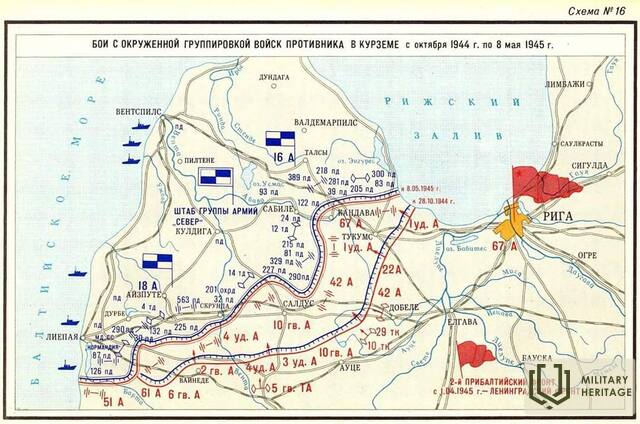

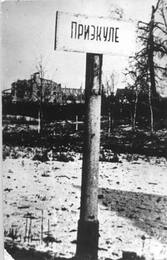
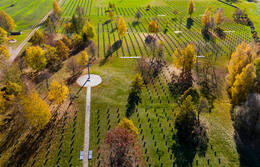
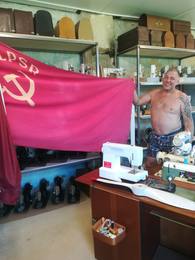
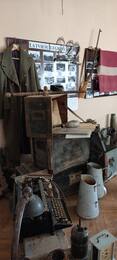
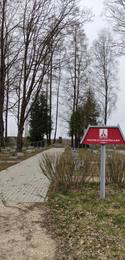
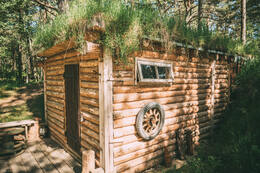
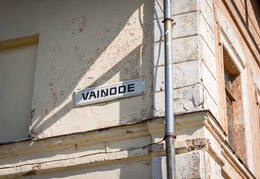
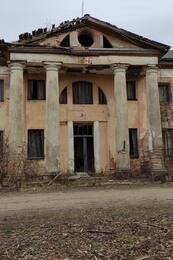
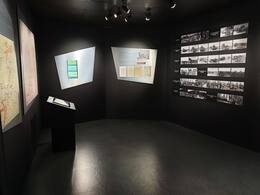
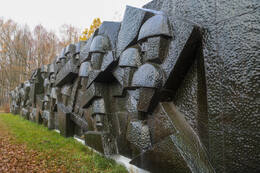
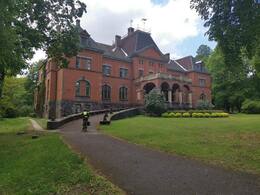
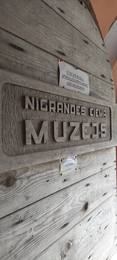
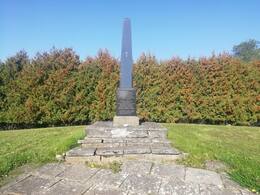
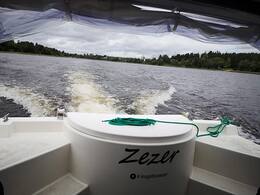
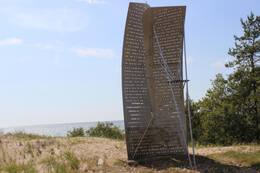
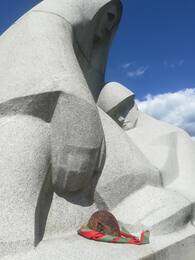
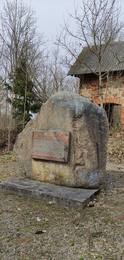
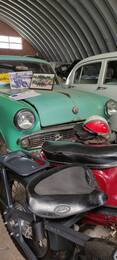
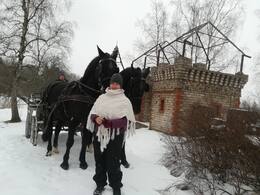
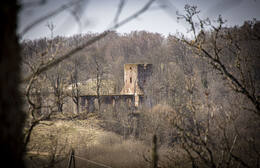
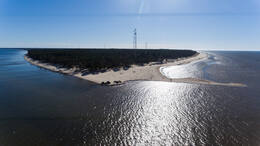
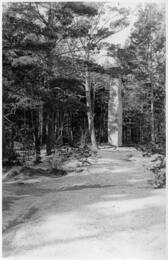
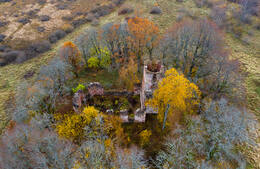
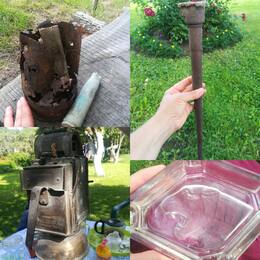
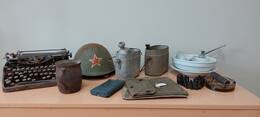
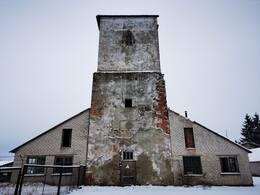
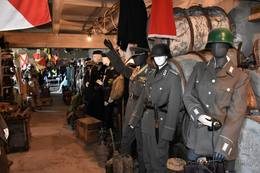
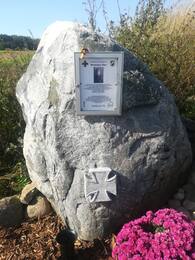
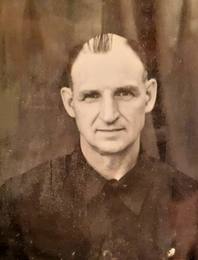
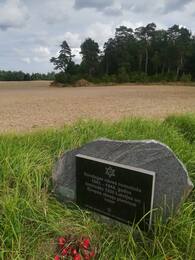
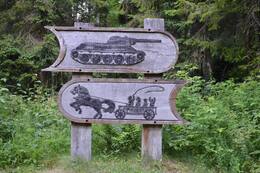
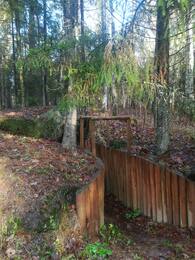
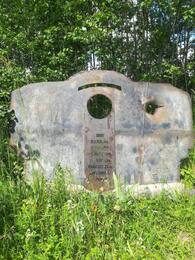
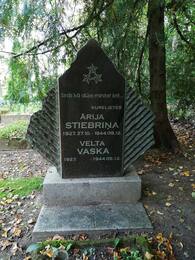
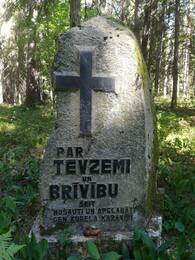
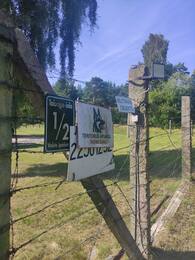
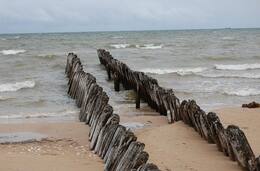
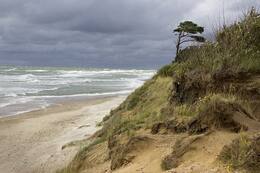
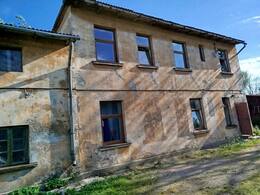
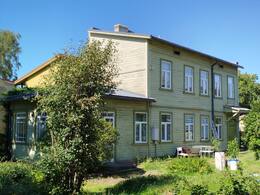
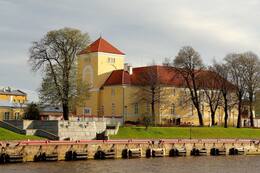
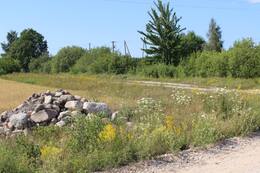
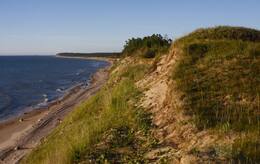
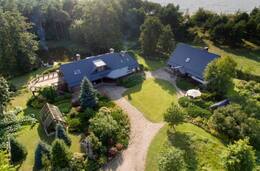
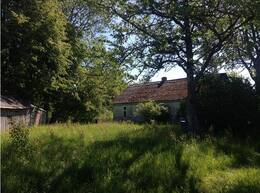
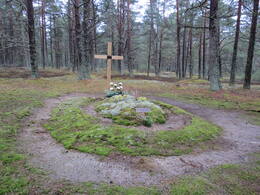
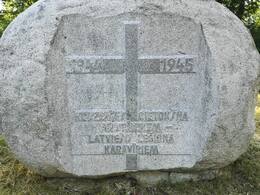
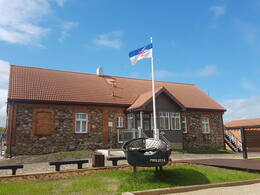

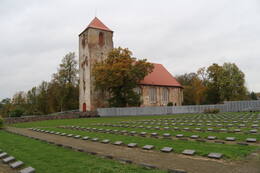

Prašau pataisyti – kariuomenės grupė vadinosi Kurša.